Overview
- Brief Narrative
- Reichsbank note, valued at 10,000 marks, distributed in Germany from January 1922 to November 1923. The front medallion depicts German artwork, Portrait of a Young Man, created by Renaissance artist Albrecht Dürer. German efforts to finance World War I sent the nation into debt. Following their defeat, the Treaty of Versailles obligated Germany to pay reparations, which increased the nation’s financial struggles. The German government attempted to solve this problem by printing more money, which led to severe inflation. When issued this note bore the highest denomination the state had ever printed. It is often called the Vampire note because the unknown engraver altered Dürer’s original portrait slightly so that when turned sideways, the face of a vampire is visible in the shadows on the man’s neck. The vampire represented France sucking the blood out of Germany because of the heavy reparations they were forced to pay. The inflation grew to critical levels between 1922 and 1923 when the exchange rate of the mark to the United States dollar went from 2,000 marks per dollar to well over a million in a matter of months. The government printed higher and higher denominations, but was unable to keep up with the plunging rates. In order to stabilize the economy, the German government established the Rentenbank. The new Minister of Finance, Hans Luther, created the Rentenmark, which was backed by mortgages on all real property in Germany, rather than gold. The Rentenmark was valued at 4.2 marks to one U.S. dollar, and its introduction on November 16, 1923, successfully ended the inflation crisis.
- Date
-
issue:
1922 January 19
publication/distribution: 1922 January 19-1923 November 16
- Geography
-
issue:
Germany.
- Credit Line
- United States Holocaust Memorial Museum Collection, Gift of Joel Forman
- Markings
- face, upper center, printed, red ink : K·00687537
face, center, printed, blue ink : Reichsbanknote / Zehntausend Mark / zahlt die Reichsbankhauptkasse in Berlin / gegen diese Banknote dem Einlieferer. / Berlin, den 19. Januar 1922 / Reichsbankdirektorium / (12 illegible signatures) [Reichsbank note Ten thousand mark The Reichsbank’s head office in Berlin pays the consignor against this banknote. Berlin, January 19, 1922 Reichsbank directorate]
face, left & right of signatures, inside seals, printed, blue ink : REICHSBANKDIREKTORIUM [Reichsbank directorate]
face, center left margin & center underprint, printed, tan ink : 10000
face, lower right, printed, blue ink : 10000
back, above Reichsadler, printed, green ink : Zehntausend Mark [Ten thousand mark]
back, over Reichsadler, printed, green ink : R*B*D / 10000 / Mark
back, under Reichsadler, printed, green ink : Wer Banknoten nachmacht oder verfälscht, oder nachge= / machte oder verfälschte sich verschafft und in Verkehr / bringt, wird mit Zuchthaus nicht unter / zwei Jahren bestraft. [Anyone who imitates or falsifies banknotes or counterfeits or falsifies procures and places them on the market is punished with a term of imprisonment of not less than two years]
back, right margin, printed, green ink : 10000 - Contributor
-
Issuer:
Reichsbankdirektorium
Physical Details
- Language
- German
- Classification
-
Exchange Media
- Category
-
Money
- Object Type
-
Emergency currency (lcsh)
- Genre/Form
- Money.
- Physical Description
- Reichsbanknote printed in blue ink on lightweight, rectangular, cream-colored paper with a repeating grid and X patterned watermark. On the face, there is a wide margin to the left of a rectangle with a geometric blue border and an overlapping, wavy tan and blue backprint. The rectangle includes a framed portrait of a man in the upper right corner, and an oval medallion bearing the denomination in the lower right corner. German text is printed on the left in fraktur-style font, and there are 12 signatures centered underneath, flanked by the Reichsbankdirektorium seal bearing a left-facing Reichsadler surrounded by German text, on both sides. The denomination is printed in tan ink as part of the backprint underneath the German text. The serial number is printed in red ink above the text. The left margin includes an elaborate, tan, geometric medallion with the denomination at the center. The back is printed in green ink, with a thick, central band of orange paper fibers embedded into the paper. The denomination is printed vertically on the right, and over a left-facing Reichsadler left of the center. German text in fraktur-style font is above and below the Reichsadler, and an elaborate geometric medallion is printed on either side. The note is lightly worn around the edges.
- Dimensions
- overall: Height: 4.000 inches (10.16 cm) | Width: 7.125 inches (18.098 cm)
- Materials
- overall : paper, ink
Rights & Restrictions
- Conditions on Access
- No restrictions on access
- Conditions on Use
- No restrictions on use
Keywords & Subjects
Administrative Notes
- Legal Status
- Permanent Collection
- Provenance
- The currency was donated to the United States Holocaust Memorial Museum in 2003 by Joel Forman.
- Record last modified:
- 2023-06-30 08:48:14
- This page:
- https://collections.ushmm.org/search/catalog/irn524942
Download & Licensing
In-Person Research
- By Appointment
- Request 21 Days in Advance of Visit
- Plan a Research Visit
- Request to See This Object
Contact Us
Also in Joel Forman collection
The collection consists of coins, currency, scrip, and stamps from various European countries, ghettos, concentration camps, prisoner of war (POW) camps, and displaced persons (DP) camps before, during, and after the Holocaust.
Date: approximately 1922-approximately 1948
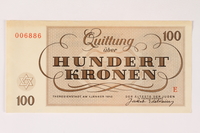
Theresienstadt ghetto-labor camp scrip, 100 kronen note
Object
Scrip, valued at 100 kronen, distributed in Theresienstadt (Terezin) ghetto-labor camp. Currency was confiscated from inmates and replaced with scrip, which could only be used in the camp. The scrip was part of an elaborate illusion to make the camp seem normal and appear as though workers were being paid for their labor, but the money had no real monetary value. The scrip was printed by the National Bank in Prague in 7 denominations: 1, 2, 5, 10, 20, 50, and 100. The notes are dated 1 January 1943, but were not distributed until May 1943. Peter Kien, a Czechoslovakian poet, artist, and inmate of Theresienstadt designed the notes, but his original design was rejected by SS General Reinhard Heydrich. He was ordered to make Moses appear more stereotypically Semitic in appearance and to arrange Moses’s hand so that it is covering one of the commandments.
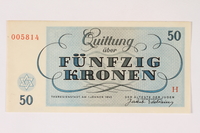
Theresienstadt ghetto-labor camp scrip, 50 kronen note
Object
Scrip, valued at 50 kronen, distributed in Theresienstadt (Terezin) ghetto-labor camp. Currency was confiscated from inmates and replaced with scrip, which could only be used in the camp. The scrip was part of an elaborate illusion to make the camp seem normal and appear as though workers were being paid for their labor, but the money had no real monetary value. The scrip was printed by the National Bank in Prague in 7 denominations: 1, 2, 5, 10, 20, 50, and 100. The notes are dated 1 January 1943, but were not distributed until May 1943. Peter Kien, a Czechoslovakian poet, artist, and inmate of Theresienstadt designed the notes, but his original design was rejected by SS General Reinhard Heydrich. He was ordered to make Moses appear more stereotypically Semitic in appearance and to arrange Moses’s hand so that it is covering one of the commandments.
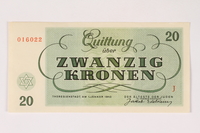
Theresienstadt ghetto-labor camp scrip, 20 kronen note
Object
Scrip, valued at 20 kronen, distributed in Theresienstadt (Terezin) ghetto-labor camp. Currency was confiscated from inmates and replaced with scrip, which could only be used in the camp. The scrip was part of an elaborate illusion to make the camp seem normal and appear as though workers were being paid for their labor, but the money had no real monetary value. The scrip was printed by the National Bank in Prague in 7 denominations: 1, 2, 5, 10, 20, 50, and 100. The notes are dated 1 January 1943, but were not distributed until May 1943. Peter Kien, a Czechoslovakian poet, artist, and inmate of Theresienstadt designed the notes, but his original design was rejected by SS General Reinhard Heydrich. He was ordered to make Moses appear more stereotypically Semitic in appearance and to arrange Moses’s hand so that it is covering one of the commandments.
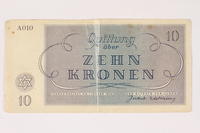
Theresienstadt ghetto-labor camp scrip, 10 kronen note
Object
Scrip, valued at 10 kronen, distributed in Theresienstadt (Terezin) ghetto-labor camp. Currency was confiscated from inmates and replaced with scrip, which could only be used in the camp. The scrip was part of an elaborate illusion to make the camp seem normal and appear as though workers were being paid for their labor, but the money had no real monetary value. The scrip was printed by the National Bank in Prague in 7 denominations: 1, 2, 5, 10, 20, 50, and 100. The notes are dated 1 January 1943, but were not distributed until May 1943. Peter Kien, a Czechoslovakian poet, artist, and inmate of Theresienstadt designed the notes, but his original design was rejected by SS General Reinhard Heydrich. He was ordered to make Moses appear more stereotypically Semitic in appearance and to arrange Moses’s hand so that it is covering one of the commandments.
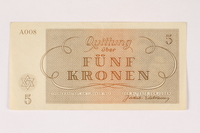
Theresienstadt ghetto-labor camp scrip, 5 kronen note
Object
Scrip, valued at 5 kronen, distributed in Theresienstadt (Terezin) ghetto-labor camp. Currency was confiscated from inmates and replaced with scrip, which could only be used in the camp. The scrip was part of an elaborate illusion to make the camp seem normal and appear as though workers were being paid for their labor, but the money had no real monetary value. The scrip was printed by the National Bank in Prague in 7 denominations: 1, 2, 5, 10, 20, 50, and 100. The notes are dated 1 January 1943, but were not distributed until May 1943. Peter Kien, a Czechoslovakian poet, artist, and inmate of Theresienstadt designed the notes, but his original design was rejected by SS General Reinhard Heydrich. He was ordered to make Moses appear more stereotypically Semitic in appearance and to arrange Moses’s hand so that it is covering one of the commandments.
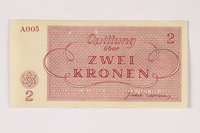
Theresienstadt ghetto-labor camp scrip, 2 kronen note
Object
Scrip, valued at 2 kronen, distributed in Theresienstadt (Terezin) ghetto-labor camp. Currency was confiscated from inmates and replaced with scrip, which could only be used in the camp. The scrip was part of an elaborate illusion to make the camp seem normal and appear as though workers were being paid for their labor, but the money had no real monetary value. The scrip was printed by the National Bank in Prague in 7 denominations: 1, 2, 5, 10, 20, 50, and 100. The notes are dated 1 January 1943, but were not distributed until May 1943. Peter Kien, a Czechoslovakian poet, artist, and inmate of Theresienstadt designed the notes, but his original design was rejected by SS General Reinhard Heydrich. He was ordered to make Moses appear more stereotypically Semitic in appearance and to arrange Moses’s hand so that it is covering one of the commandments.
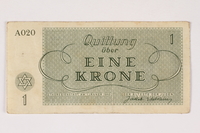
Theresienstadt ghetto-labor camp scrip, 1 krone note
Object
Scrip, valued at 1 krone, distributed in Theresienstadt (Terezin) ghetto-labor camp. Currency was confiscated from inmates and replaced with scrip, which could only be used in the camp. The scrip was part of an elaborate illusion to make the camp seem normal and appear as though workers were being paid for their labor, but the money had no real monetary value. The scrip was printed by the National Bank in Prague in 7 denominations: 1, 2, 5, 10, 20, 50, and 100. The notes are dated 1 January 1943, but were not distributed until May 1943. Peter Kien, a Czechoslovakian poet, artist, and inmate of Theresienstadt designed the notes, but his original design was rejected by SS General Reinhard Heydrich. He was ordered to make Moses appear more stereotypically Semitic in appearance and to arrange Moses’s hand so that it is covering one of the commandments.
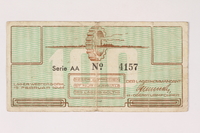
Westerbork transit camp voucher, 100 cent note
Object
Voucher, valued at 100 cents, distributed in Westerbork transit camp. While at the camp, inmates were compelled to work, and a special currency was issued to incentivize work output, but the money had no real monetary value outside the camp. Westerbork was established by the Dutch government in October 1939, for Jewish refugees who had crossed the border illegally following the Kristallnacht pogrom of November 1938. After Germany invaded the Netherlands on May 10, 1940, the German authorities began using Westerbork as a transit camp, holding internees until they were deported to forced labor camps or killing centers in other countries. Westerbork was under the authority of a German commandant, Albert Gemmeker, but run and supplied by the Jewish Community. Deportations from Westerbork began in February 1941. Inmates could occasionally purchase small supplies from the camp canteen, but food was not available. The special currency was first distributed in 1944, and designed by Werner Löwenhardt, a Jewish artist who was imprisoned by the Germans in Westerbork from October 1942, until the camp was liberated in April 1945. The front design features a large chimney from the camp laundry and a street known as the Boulevard of Misery. The back design again features the chimney, in addition to a large, toothed spur gear. Both images support an illusion of an industrious camp as well as the hopelessness of inevitable deportation.
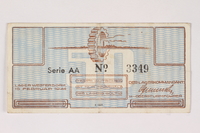
Westerbork transit camp voucher, 50 cent note
Object
Voucher, valued at 50 cents, distributed in Westerbork transit camp. While at the camp, inmates were compelled to work, and a special currency was issued to incentivize work output, but the money had no real monetary value outside the camp. Westerbork was established by the Dutch government in October 1939, for Jewish refugees who had crossed the border illegally following the Kristallnacht pogrom of November 1938. After Germany invaded the Netherlands on May 10, 1940, the German authorities began using Westerbork as a transit camp, holding internees until they were deported to forced labor camps or killing centers in other countries. Westerbork was under the authority of a German commandant, Albert Gemmeker, but run and supplied by the Jewish Community. Deportations from Westerbork began in February 1941. Inmates could occasionally purchase small supplies from the camp canteen, but food was not available. The special currency was first distributed in 1944, and designed by Werner Löwenhardt, a Jewish artist who was imprisoned by the Germans in Westerbork from October 1942, until the camp was liberated in April 1945. The front design features a large chimney from the camp laundry and a street known as the Boulevard of Misery. The back design again features the chimney, in addition to a large, toothed spur gear. Both images support an illusion of an industrious camp as well as the hopelessness of inevitable deportation.
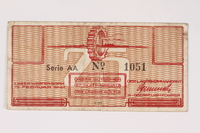
Westerbork transit camp voucher, 25 cent note
Object
Voucher, valued at 25 cents, distributed in Westerbork transit camp. While at the camp, inmates were compelled to work, and a special currency was issued to incentivize work output, but the money had no real monetary value outside the camp. Westerbork was established by the Dutch government in October 1939, for Jewish refugees who had crossed the border illegally following the Kristallnacht pogrom of November 1938. After Germany invaded the Netherlands on May 10, 1940, the German authorities began using Westerbork as a transit camp, holding internees until they were deported to forced labor camps or killing centers in other countries. Westerbork was under the authority of a German commandant, Albert Gemmeker, but run and supplied by the Jewish Community. Deportations from Westerbork began in February 1941. Inmates could occasionally purchase small supplies from the camp canteen, but food was not available. The special currency was first distributed in 1944, and designed by Werner Löwenhardt, a Jewish artist who was imprisoned by the Germans in Westerbork from October 1942, until the camp was liberated in April 1945. The front design features a large chimney from the camp laundry and a street known as the Boulevard of Misery. The back design again features the chimney, in addition to a large, toothed spur gear. Both images support an illusion of an industrious camp as well as the hopelessness of inevitable deportation.
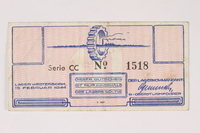
Westerbork transit camp voucher, 10 cent note
Object
Voucher, valued at 10 cents, distributed in Westerbork transit camp. While at the camp, inmates were compelled to work, and a special currency was issued to incentivize work output, but the money had no real monetary value outside the camp. Westerbork was established by the Dutch government in October 1939, for Jewish refugees who had crossed the border illegally following the Kristallnacht pogrom of November 1938. After Germany invaded the Netherlands on May 10, 1940, the German authorities began using Westerbork as a transit camp, holding internees until they were deported to forced labor camps or killing centers in other countries. Westerbork was under the authority of a German commandant, Albert Gemmeker, but run and supplied by the Jewish Community. Deportations from Westerbork began in February 1941. Inmates could occasionally purchase small supplies from the camp canteen, but food was not available. The special currency was first distributed in 1944, and designed by Werner Löwenhardt, a Jewish artist who was imprisoned by the Germans in Westerbork from October 1942, until the camp was liberated in April 1945. The front design features a large chimney from the camp laundry and a street known as the Boulevard of Misery. The back design again features the chimney, in addition to a large, toothed spur gear. Both images support an illusion of an industrious camp as well as the hopelessness of inevitable deportation.
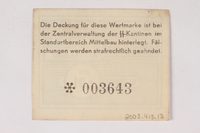
Mittelbau forced labor camp scrip, .01 Reichsmark note
Object
Scrip (also called chits) valued at 0.01 Reichsmark, distributed to slave laborers in Mittelbau (Central Construction) concentration camp. Mittelbau (also called Dora-Mittelbau and Nordhausen), located near the town of Nordhausen, was originally established on August 28, 1943, as a subcamp of Buchenwald, with the codename, Dora. In response to increased Allied bombing, prisoners were forced to dig huge tunnels in the mountains, safe from aerial destruction. Inside the completed tunnels, the prisoners then constructed factories and storage areas for rocket production. Once completed, assembly line production of V-2 rockets began in late December of 1943. Both forced laborers and German civil workers worked on rocket construction. To encourage productivity on the assembly line, authorities paid the prisoners with scrip which could be exchanged for goods in the camp canteen. Nine denominations were issued: 0.01, 0.05, 0.10, 0.25, 0.50, 1, 2, 5, and 10 marks. In 1944, Mittelbau was converted into an independent concentration camp with over 30 subcamps of its own. On April 4, 1945, with the Allied forces approaching, the Nazis began to remove and destroy evidence of their activities. This included the evacuation of prisoners from the camp and the destruction of documentation relating to the production of the scrip. Mittelbau was liberated on April 11, 1945, by elements of the U.S. 3rd Armored and 104th Infantry Divisions.
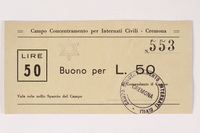
Cremona concentration camp scrip, 50 Lire note with a Star of David stamp
Object
Scrip, valued at 50 Lire, distributed in Cremona concentration camp in Cremona, Italy. Under German pressure, Italian fascists passed antisemitic legislation in 1938, and later established domestic concentration camps for military and civilian internees. However, the Italian authorities resisted participating in the mass murder and did not permit deportations of Jews from Italy. Although the camps were called Campi Di Concetramento (Concentration Camps) the conditions and treatment of their internees were equivalent to prisoner of war (POW) camps for military and civilians. Prisoners, including Jews, were treated much better than their counterparts in the German camps. Cremona concentration camp was an internment and labor camp that held both POWs and Jewish prisoners. Scrip was issued to Cremona’s prisoners in exchange for outside currency to inhibit escape attempts. The scrip was printed in seven denominations: 0.50, 1, 2, 5, 10, 20, and 50 Lire. There are two versions of the scrip known today: notes printed on cardstock with a Star of David stamp, and notes printed on paper without a stamp. Expert numismatists disagree on the authenticity of the Star of David stamp version, with one side believing the Star of David stamped scrip was issued to Jewish prisoners in the camp, while the other believes the notes are not genuine. After the war, a Displaced Persons (DP) Camp was established by the United Nations Relief and Rehabilitation Administration (UNRRA) in Cremona from 1945-1947. In 1946 an ORT (Obchestvo Remeslenogo Truda, Association for the Promotion of Skilled Trades) vocational school was established in the camp. The camp housed between 1,000 and 1,200 refugees, and was one of the largest centers for DPs in Italy.
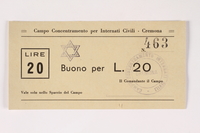
Cremona concentration camp scrip, 20 Lire note with a Star of David stamp
Object
Scrip, valued at 20 Lire, distributed in Cremona concentration camp in Cremona, Italy. Under German pressure, Italian fascists passed antisemitic legislation in 1938, and later established domestic concentration camps for military and civilian internees. However, the Italian authorities resisted participating in the mass murder and did not permit deportations of Jews from Italy. Although the camps were called Campi Di Concetramento (Concentration Camps) the conditions and treatment of their internees were equivalent to prisoner of war (POW) camps for military and civilians. Prisoners, including Jews, were treated much better than their counterparts in the German camps. Cremona concentration camp was an internment and labor camp that held both POWs and Jewish prisoners. Scrip was issued to Cremona’s prisoners in exchange for outside currency to inhibit escape attempts. The scrip was printed in seven denominations: 0.50, 1, 2, 5, 10, 20, and 50 Lire. There are two versions of the scrip known today: notes printed on cardstock with a Star of David stamp, and notes printed on paper without a stamp. Expert numismatists disagree on the authenticity of the Star of David stamp version, with one side believing the Star of David stamped scrip was issued to Jewish prisoners in the camp, while the other believes the notes are not genuine. After the war, a Displaced Persons (DP) Camp was established by the United Nations Relief and Rehabilitation Administration (UNRRA) in Cremona from 1945-1947. In 1946 an ORT (Obchestvo Remeslenogo Truda, Association for the Promotion of Skilled Trades) vocational school was established in the camp. The camp housed between 1,000 and 1,200 refugees, and was one of the largest centers for DPs in Italy.
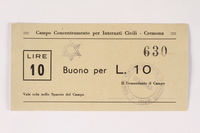
Cremona concentration camp scrip, 10 Lire note with a Star of David stamp
Object
Scrip, valued at 10 Lire, distributed in Cremona concentration camp in Cremona, Italy. Under German pressure, Italian fascists passed antisemitic legislation in 1938, and later established domestic concentration camps for military and civilian internees. However, the Italian authorities resisted participating in the mass murder and did not permit deportations of Jews from Italy. Although the camps were called Campi Di Concetramento (Concentration Camps) the conditions and treatment of their internees were equivalent to prisoner of war (POW) camps for military and civilians. Prisoners, including Jews, were treated much better than their counterparts in the German camps. Cremona concentration camp was an internment and labor camp that held both POWs and Jewish prisoners. Scrip was issued to Cremona’s prisoners in exchange for outside currency to inhibit escape attempts. The scrip was printed in seven denominations: 0.50, 1, 2, 5, 10, 20, and 50 Lire. There are two versions of the scrip known today: notes printed on cardstock with a Star of David stamp, and notes printed on paper without a stamp. Expert numismatists disagree on the authenticity of the Star of David stamp version, with one side believing the Star of David stamped scrip was issued to Jewish prisoners in the camp, while the other believes the notes are not genuine. After the war, a Displaced Persons (DP) Camp was established by the United Nations Relief and Rehabilitation Administration (UNRRA) in Cremona from 1945-1947. In 1946 an ORT (Obchestvo Remeslenogo Truda, Association for the Promotion of Skilled Trades) vocational school was established in the camp. The camp housed between 1,000 and 1,200 refugees, and was one of the largest centers for DPs in Italy.
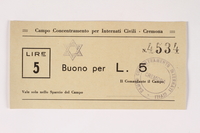
Cremona concentration camp scrip, 5 Lire note with a Star of David stamp
Object
Scrip, valued at 5 Lire, distributed in Cremona concentration camp in Cremona, Italy. Under German pressure, Italian fascists passed antisemitic legislation in 1938, and later established domestic concentration camps for military and civilian internees. However, the Italian authorities resisted participating in the mass murder and did not permit deportations of Jews from Italy. Although the camps were called Campi Di Concetramento (Concentration Camps) the conditions and treatment of their internees were equivalent to prisoner of war (POW) camps for military and civilians. Prisoners, including Jews, were treated much better than their counterparts in the German camps. Cremona concentration camp was an internment and labor camp that held both POWs and Jewish prisoners. Scrip was issued to Cremona’s prisoners in exchange for outside currency to inhibit escape attempts. The scrip was printed in seven denominations: 0.50, 1, 2, 5, 10, 20, and 50 Lire. There are two versions of the scrip known today: notes printed on cardstock with a Star of David stamp, and notes printed on paper without a stamp. Expert numismatists disagree on the authenticity of the Star of David stamp version, with one side believing the Star of David stamped scrip was issued to Jewish prisoners in the camp, while the other believes the notes are not genuine. After the war, a Displaced Persons (DP) Camp was established by the United Nations Relief and Rehabilitation Administration (UNRRA) in Cremona from 1945-1947. In 1946 an ORT (Obchestvo Remeslenogo Truda, Association for the Promotion of Skilled Trades) vocational school was established in the camp. The camp housed between 1,000 and 1,200 refugees, and was one of the largest centers for DPs in Italy.
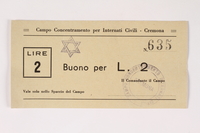
Cremona concentration camp scrip, 2 Lire note with a Star of David stamp
Object
Scrip, valued at 2 Lire, distributed in Cremona concentration camp in Cremona, Italy. Under German pressure, Italian fascists passed antisemitic legislation in 1938, and later established domestic concentration camps for military and civilian internees. However, the Italian authorities resisted participating in the mass murder and did not permit deportations of Jews from Italy. Although the camps were called Campi Di Concetramento (Concentration Camps) the conditions and treatment of their internees were equivalent to prisoner of war (POW) camps for military and civilians. Prisoners, including Jews, were treated much better than their counterparts in the German camps. Cremona concentration camp was an internment and labor camp that held both POWs and Jewish prisoners. Scrip was issued to Cremona’s prisoners in exchange for outside currency to inhibit escape attempts. The scrip was printed in seven denominations: 0.50, 1, 2, 5, 10, 20, and 50 Lire. There are two versions of the scrip known today: notes printed on cardstock with a Star of David stamp, and notes printed on paper without a stamp. Expert numismatists disagree on the authenticity of the Star of David stamp version, with one side believing the Star of David stamped scrip was issued to Jewish prisoners in the camp, while the other believes the notes are not genuine. After the war, a Displaced Persons (DP) Camp was established by the United Nations Relief and Rehabilitation Administration (UNRRA) in Cremona from 1945-1947. In 1946 an ORT (Obchestvo Remeslenogo Truda, Association for the Promotion of Skilled Trades) vocational school was established in the camp. The camp housed between 1,000 and 1,200 refugees, and was one of the largest centers for DPs in Italy.
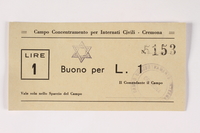
Cremona concentration camp scrip, 1 Lire note with a Star of David stamp
Object
Scrip, valued at 1 Lire, distributed in Cremona concentration camp in Cremona, Italy. Under German pressure, Italian fascists passed antisemitic legislation in 1938, and later established domestic concentration camps for military and civilian internees. However, the Italian authorities resisted participating in the mass murder and did not permit deportations of Jews from Italy. Although the camps were called Campi Di Concetramento (Concentration Camps) the conditions and treatment of their internees were equivalent to prisoner of war (POW) camps for military and civilians. Prisoners, including Jews, were treated much better than their counterparts in the German camps. Cremona concentration camp was an internment and labor camp that held both POWs and Jewish prisoners. Scrip was issued to Cremona’s prisoners in exchange for outside currency to inhibit escape attempts. The scrip was printed in seven denominations: 0.50, 1, 2, 5, 10, 20, and 50 Lire. There are two versions of the scrip known today: notes printed on cardstock with a Star of David stamp, and notes printed on paper without a stamp. Expert numismatists disagree on the authenticity of the Star of David stamp version, with one side believing the Star of David stamped scrip was issued to Jewish prisoners in the camp, while the other believes the notes are not genuine. After the war, a Displaced Persons (DP) Camp was established by the United Nations Relief and Rehabilitation Administration (UNRRA) in Cremona from 1945-1947. In 1946 an ORT (Obchestvo Remeslenogo Truda, Association for the Promotion of Skilled Trades) vocational school was established in the camp. The camp housed between 1,000 and 1,200 refugees, and was one of the largest centers for DPs in Italy.
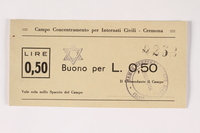
Cremona concentration camp scrip, 0.50 Lire note with a Star of David Stamp
Object
Scrip, valued at 0.50 Lire, distributed in Cremona concentration camp in Cremona, Italy. Under German pressure, Italian fascists passed antisemitic legislation in 1938, and later established domestic concentration camps for military and civilian internees. However, the Italian authorities resisted participating in the mass murder and did not permit deportations of Jews from Italy. Although the camps were called Campi Di Concetramento (Concentration Camps) the conditions and treatment of their internees were equivalent to prisoner of war (POW) camps for military and civilians. Prisoners, including Jews, were treated much better than their counterparts in the German camps. Cremona concentration camp was an internment and labor camp that held both POWs and Jewish prisoners. Scrip was issued to Cremona’s prisoners in exchange for outside currency to inhibit escape attempts. The scrip was printed in seven denominations: 0.50, 1, 2, 5, 10, 20, and 50 Lire. There are two versions of the scrip known today: notes printed on cardstock with a Star of David stamp, and notes printed on paper without a stamp. Expert numismatists disagree on the authenticity of the Star of David stamp version, with one side believing the Star of David stamped scrip was issued to Jewish prisoners in the camp, while the other believes the notes are not genuine. After the war, a Displaced Persons (DP) Camp was established by the United Nations Relief and Rehabilitation Administration (UNRRA) in Cremona from 1945-1947. In 1946 an ORT (Obchestvo Remeslenogo Truda, Association for the Promotion of Skilled Trades) vocational school was established in the camp. The camp housed between 1,000 and 1,200 refugees, and was one of the largest centers for DPs in Italy.
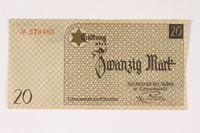
Łódź (Litzmannstadt) ghetto scrip, 20 mark note
Object
Scrip, valued at 20 marks, distributed in Łódź (Litzmannstadt) ghetto. The Jewish Council was ordered to create a system of Quittungen (receipts) that could be used as currency only in the ghetto. Valuables and currency were forcibly exchanged for the scrip and it was used as modest payment for forced laborers, though it held no value outside the ghetto. Ignacy Gutman designed all the denominations of the paper scrip and they were printed by the Manitius Printing House. The coins were designed by Pinkus Szwarc and minted in the ghetto by inmates. The Łódź ghetto was the only German ghetto or concentration camp that minted coinage. The scrip was issued in the German-controlled ghetto from June of 1940 to its liquidation in the fall of 1944. The scrip, sometimes referred to as rumki or chaimki, after the Elder of the Judenrat, Chaim Mordechai Rumkowski and was issued in denominations of: 1, 2, 5, 10, 20, and 50 mark notes; 5, 10, and 20 mark coins; and 50 pfennig notes and 10 pfennig coins.
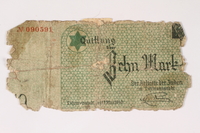
Łódź (Litzmannstadt) ghetto scrip, 10 mark note
Object
Scrip, valued at 10 marks, distributed in Łódź (Litzmannstadt) ghetto. The Jewish Council was ordered to create a system of Quittungen (receipts) that could be used as currency only in the ghetto. Valuables and currency were forcibly exchanged for the scrip and it was used as modest payment for forced laborers, though it held no value outside the ghetto. Ignacy Gutman designed all the denominations of the paper scrip and they were printed by the Manitius Printing House. The coins were designed by Pinkus Szwarc and minted in the ghetto by inmates. The Łódź ghetto was the only German ghetto or concentration camp that minted coinage. The scrip was issued in the German-controlled ghetto from June of 1940 to its liquidation in the fall of 1944. The scrip, sometimes referred to as rumki or chaimki, after the Elder of the Judenrat, Chaim Mordechai Rumkowski and was issued in denominations of: 1, 2, 5, 10, 20, and 50 mark notes; 5, 10, and 20 mark coins; and 50 pfennig notes and 10 pfennig coins.
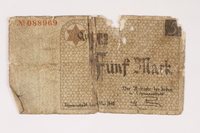
Łódź (Litzmannstadt) ghetto scrip, 5 mark note
Object
Scrip, valued at 5 marks, distributed in Łódź (Litzmannstadt) ghetto. The Jewish Council was ordered to create a system of Quittungen (receipts) that could be used as currency only in the ghetto. Valuables and currency were forcibly exchanged for the scrip and it was used as modest payment for forced laborers, though it held no value outside the ghetto. Ignacy Gutman designed all the denominations of the paper scrip and they were printed by the Manitius Printing House. The coins were designed by Pinkus Szwarc and minted in the ghetto by inmates. The Łódź ghetto was the only German ghetto or concentration camp that minted coinage. The scrip was issued in the German-controlled ghetto from June of 1940 to its liquidation in the fall of 1944. The scrip, sometimes referred to as rumki or chaimki, after the Elder of the Judenrat, Chaim Mordechai Rumkowski and was issued in denominations of: 1, 2, 5, 10, 20, and 50 mark notes; 5, 10, and 20 mark coins; and 50 pfennig notes and 10 pfennig coins.
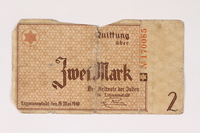
Łódź (Litzmannstadt) ghetto scrip, 2 mark note
Object
Scrip, valued at 2 marks, distributed in Łódź (Litzmannstadt) ghetto. The Jewish Council was ordered to create a system of Quittungen (receipts) that could be used as currency only in the ghetto. Valuables and currency were forcibly exchanged for the scrip and it was used as modest payment for forced laborers, though it held no value outside the ghetto. Ignacy Gutman designed all the denominations of the paper scrip and they were printed by the Manitius Printing House. The coins were designed by Pinkus Szwarc and minted in the ghetto by inmates. The Łódź ghetto was the only German ghetto or concentration camp that minted coinage. The scrip was issued in the German-controlled ghetto from June of 1940 to its liquidation in the fall of 1944. The scrip, sometimes referred to as rumki or chaimki, after the Elder of the Judenrat, Chaim Mordechai Rumkowski and was issued in denominations of: 1, 2, 5, 10, 20, and 50 mark notes; 5, 10, and 20 mark coins; and 50 pfennig notes and 10 pfennig coins.
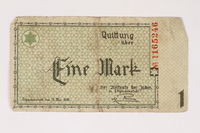
Łódź (Litzmannstadt) ghetto scrip, 1 mark note
Object
Scrip, valued at 1 mark, distributed in Łódź (Litzmannstadt) ghetto. The Jewish Council was ordered to create a system of Quittungen (receipts) that could be used as currency only in the ghetto. Valuables and currency were forcibly exchanged for the scrip and it was used as modest payment for forced laborers, though it held no value outside the ghetto. Ignacy Gutman designed all the denominations of the paper scrip and they were printed by the Manitius Printing House. The coins were designed by Pinkus Szwarc and minted in the ghetto by inmates. The Łódź ghetto was the only German ghetto or concentration camp that minted coinage. The scrip was issued in the German-controlled ghetto from June of 1940 to its liquidation in the fall of 1944. The scrip, sometimes referred to as rumki or chaimki, after the Elder of the Judenrat, Chaim Mordechai Rumkowski and was issued in denominations of: 1, 2, 5, 10, 20, and 50 mark notes; 5, 10, and 20 mark coins; and 50 pfennig notes and 10 pfennig coins.
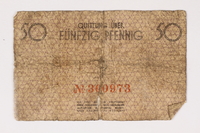
Łódź (Litzmannstadt) ghetto scrip, 50 pfennig note
Object
Scrip, valued at 50 pfennig, distributed in Łódź (Litzmannstadt) ghetto. The Jewish Council was ordered to create a system of Quittungen (receipts) that could be used as currency only in the ghetto. Valuables and currency were forcibly exchanged for the scrip and it was used as modest payment for forced laborers, though it held no value outside the ghetto. Ignacy Gutman designed all the denominations of the paper scrip and they were printed by the Manitius Printing House. The coins were designed by Pinkus Szwarc and minted in the ghetto by inmates. The Łódź ghetto was the only German ghetto or concentration camp that minted coinage. The scrip was issued in the German-controlled ghetto from June of 1940 to its liquidation in the fall of 1944. The scrip, sometimes referred to as rumki or chaimki, after the Elder of the Judenrat, Chaim Mordechai Rumkowski and was issued in denominations of: 1, 2, 5, 10, 20, and 50 mark notes; 5, 10, and 20 mark coins; and 50 pfennig notes and 10 pfennig coins.
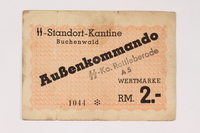
Buchenwald subcamp scrip, 2 Reichsmark note for use in Rottleberode
Object
Scrip, valued at 2 Reichsmark, distributed in Rottleberode, a subcamp of Buchenwald concentration camp in Germany. While held at the camp, inmates were compelled to work, and a special currency was issued to incentivize work output, though the money had no real monetary value. Buchenwald operated 134 subcamps, and issued two different types of special currency. The exchange scrip had Außenkommando, outside command, printed across the front, and was issued to inmates working in the Buchenwald subcamps. The canteen scrip, which did not have Außenkommando printed on it, was used in the main camp. Both types of notes were issued in .50, 1, 2, and 3 mark denominations. Rottleberode opened as a subcamp of Buchenwald in March 1944, when prisoners were sent to excavate caves in the area. In October 1944, Mittelbau (Central Construction) concentration camp (also called Dora-Mittelbau and Nordhausen) in Germany, took over administration of Rottleberode. Under both administrations, inmates worked as forced laborers for the Junkers aircraft factory. The subcamp was evacuated in April 1945, as Allied forces approached. The prisoners were sent on forced marches to Niedersachswerfen subcamp and Sachsenhausen concentration camp in Germany. The majority of them did not survive.
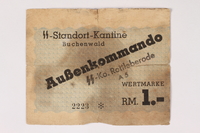
Buchenwald subcamp scrip, 1 Reichsmark note for use in Rottleberode
Object
Scrip, valued at 1 Reichsmark, distributed in Rottleberode, a subcamp of Buchenwald concentration camp in Germany. While held at the camp, inmates were compelled to work, and a special currency was issued to incentivize work output, though the money had no real monetary value. Buchenwald operated 134 subcamps, and issued two different types of special currency. The exchange scrip had Außenkommando, outside command, printed across the front, and was issued to inmates working in the Buchenwald subcamps. The canteen scrip, which did not have Außenkommando printed on it, was used in the main camp. Both types of notes were issued in .50, 1, 2, and 3 mark denominations. Rottleberode opened as a subcamp of Buchenwald in March 1944, when prisoners were sent to excavate caves in the area. In October 1944, Mittelbau (Central Construction) concentration camp (also called Dora-Mittelbau and Nordhausen) in Germany, took over administration of Rottleberode. Under both administrations, inmates worked as forced laborers for the Junkers aircraft factory. The subcamp was evacuated in April 1945, as Allied forces approached. The prisoners were sent on forced marches to Niedersachswerfen subcamp and Sachsenhausen concentration camp in Germany. The majority of them did not survive.
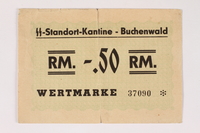
Buchenwald concentration camp scrip, -.50 Reichsmark note, inscribed by an inmate
Object
Scrip, valued at .50 Reichsmark, distributed in Buchenwald concentration camp in Germany, with a handwritten inscription from a former inmate on the back. While held at the camp, inmates were compelled to work, and a special currency was issued to incentivize work output, though the money had no real monetary value. Buchenwald operated 134 subcamps, and issued two different types of special currency. The exchange scrip had Außenkommando, outside command, printed across the front, and was issued to inmates working in the Buchenwald subcamps. The canteen scrip, which did not have Außenkommando printed on it, was used in the main camp. Both types of notes were issued in .50, 1, 2, and 3 mark denominations. Buchenwald was established by the German government in July 1937, mainly to confine political prisoners. Jewish prisoners did not arrive at the camp until November 1938, when German SS and police officers began sending large numbers of Jewish men following the Kristallnacht program. Women were not sent to the camp until late 1943 or early 1944, and they worked mainly in the munitions factories in the subcamps. In early April 1945, as US forces approached Buchenwald concentration camp, the German guards began to evacuate the camp. On April 11, the prisoners revolted and seized control of the facilities. Later that day, US soldiers from the Sixth Army Armored Division, part of the Third Army, arrived in camp and discovered more than 21,000 starving and ill inmates.
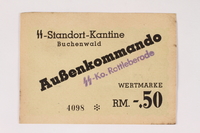
Buchenwald subcamp scrip, -.50 Reichsmark note for use in Rottleberode
Object
Scrip, valued at .50 Reichsmark, distributed in Rottleberode, a subcamp of Buchenwald concentration camp in Germany. While held at the camp, inmates were compelled to work, and a special currency was issued to incentivize work output, though the money had no real monetary value. Buchenwald operated 134 subcamps, and issued two different types of special currency. The exchange scrip had Außenkommando, outside command, printed across the front, and was issued to inmates working in the Buchenwald subcamps. The canteen scrip, which did not have Außenkommando printed on it, was used in the main camp. Both types of notes were issued in .50, 1, 2, and 3 mark denominations. Rottleberode opened as a subcamp of Buchenwald in March 1944, when prisoners were sent to excavate caves in the area. In October 1944, Mittelbau (Central Construction) concentration camp (also called Dora-Mittelbau and Nordhausen) in Germany, took over administration of Rottleberode. Under both administrations, inmates worked as forced laborers for the Junkers aircraft factory. The subcamp was evacuated in April 1945, as Allied forces approached. The prisoners were sent on forced marches to Niedersachswerfen subcamp and Sachsenhausen concentration camp in Germany. The majority of them did not survive.
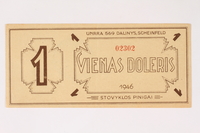
Scheinfeld Displaced Persons Camp scrip, 1 dollar note
Object
Scrip, valued at 1 dollar, distributed in Scheinfeld displaced persons camp (DP) in Scheinfeld, Germany from April until July, 1946. The United Nations Relief and Rehabilitation Administration (UNRRA) team 596 issued three denominations of scrip: 10 cents, 50 cents, and 1 dollar. The scrip was used in the canteen until July, but was abandoned due to food shortages. During World War II, many Lithuanians were deported to Nazi Germany as forced laborers. Toward the end of the war, many more escaped Lithuania before the advancing Soviet army, fearing a continuation of the mass arrests and deportations the Soviets inflicted on the public during their occupation under the Molotov–Ribbentrop Pact. Consequently, after World War II, Germany had a large population of Lithuanian displaced persons (DPs). The Scheinfeld DP camp was established on April 28, 1946, by the United Nations Relief and Rehabilitation Administration (UNRRA). An agency that provided DPs with food, clothing, medicine, and helped to repatriate people to their home countries. The camp housed 1,500 Lithuanian displaced persons who had been transferred from Regensburg DP camp, and was overseen by UNRRA team 569. The camp was located on the grounds of the 17th century, Schwarzenberg castle, and included a hospital, dental clinic, sanitation office, drug store, canteen, bakery, clothing store, two restaurants, and laundry and shoe repair services. In the barrack section, a large hall held various programs, concerts, lectures, and plays. The camp was closed in the autumn of 1949. It was thought that all the notes were destroyed, until approximately 15 sets were discovered in England in the 1970s.
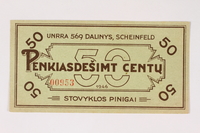
Scheinfeld Displaced Persons Camp scrip, 50 cent note
Object
Scrip, valued at 50 cents distributed in Scheinfeld displaced persons camp (DP) in Scheinfeld, Germany from April until July, 1946. The United Nations Relief and Rehabilitation Administration (UNRRA) team 596 issued three denominations of scrip: 10 cents, 50 cents, and 1 dollar. The scrip was used in the canteen until July, but was abandoned due to food shortages. During World War II, many Lithuanians were deported to Nazi Germany as forced laborers. Toward the end of the war, many more escaped Lithuania before the advancing Soviet army, fearing a continuation of the mass arrests and deportations the Soviets inflicted on the public during their occupation under the Molotov–Ribbentrop Pact. Consequently, after World War II, Germany had a large population of Lithuanian displaced persons (DPs). The Scheinfeld DP camp was established on April 28, 1946, by the United Nations Relief and Rehabilitation Administration (UNRRA). An agency that provided DPs with food, clothing, medicine, and helped to repatriate people to their home countries. The camp housed 1,500 Lithuanian displaced persons who had been transferred from Regensburg DP camp, and was overseen by UNRRA team 569. The camp was located on the grounds of the 17th century, Schwarzenberg castle, and included a hospital, dental clinic, sanitation office, drug store, canteen, bakery, clothing store, two restaurants, and laundry and shoe repair services. In the barrack section, a large hall held various programs, concerts, lectures, and plays. The camp was closed in the autumn of 1949. It was thought that all the notes were destroyed, until approximately 15 sets were discovered in England in the 1970s.
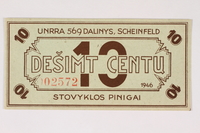
Scheinfeld Displaced Persons Camp scrip, 10 cent note
Object
Scrip, valued at 10 cents distributed in Scheinfeld displaced persons camp (DP) in Scheinfeld, Germany from April until July, 1946. The United Nations Relief and Rehabilitation Administration (UNRRA) team 596 issued three denominations of scrip: 10 cents, 50 cents, and 1 dollar. The scrip was used in the canteen until July, but was abandoned due to food shortages. During World War II, many Lithuanians were deported to Nazi Germany as forced laborers. Toward the end of the war, many more escaped Lithuania before the advancing Soviet army, fearing a continuation of the mass arrests and deportations the Soviets inflicted on the public during their occupation under the Molotov–Ribbentrop Pact. Consequently, after World War II, Germany had a large population of Lithuanian displaced persons (DPs). The Scheinfeld DP camp was established on April 28, 1946, by the United Nations Relief and Rehabilitation Administration (UNRRA). An agency that provided DPs with food, clothing, medicine, and helped to repatriate people to their home countries. The camp housed 1,500 Lithuanian displaced persons who had been transferred from Regensburg DP camp, and was overseen by UNRRA team 569. The camp was located on the grounds of the 17th century, Schwarzenberg castle, and included a hospital, dental clinic, sanitation office, drug store, canteen, bakery, clothing store, two restaurants, and laundry and shoe repair services. In the barrack section, a large hall held various programs, concerts, lectures, and plays. The camp was closed in the autumn of 1949. It was thought that all the notes were destroyed, until approximately 15 sets were discovered in England in the 1970s.
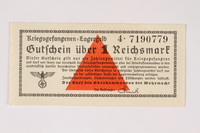
German Prisoner of War camp general issue currency, kriegsgefangenen lagergeld, 1 Reichsmark
Object
German prisoner of war (POW) currency, called kriegsgfangenen lagergeld (war cash), valued at 1 Reichsmark, distributed to prisoners held in German POW camps from 1939 to 1944. The currency was issued in seven denominations: 1, 10, and 50 Reichspfennig and 1, 2, 5, and 10 Reichsmark. After the beginning of World War II in September, 1939, Nazi Germany established a network of approximately 75 POW camps to house the enemy soldiers they captured across Europe. A prisoner’s treatment inside the camps varied depending on their nationality. Due to the Nazi belief that Soviet prisoners were racially and politically inferior, they were starved and treated brutally, resulting in millions of deaths. However, for Western Allied prisoners, life inside the camps was tough but generally fair, as Germany, with some exceptions, usually followed the Geneva Convention Rules for ethical treatment of POWs. Prisoners received meager rations supplemented with Red Cross food parcels and, with the exception of officers, were required to work, often performing hard labor. To compensate the prisoners for their work, Germany distributed currency that was to be used in the POW camps. The notes only held value in the POW camps and their official use was for the purchase of goods from the canteens. However, the canteens were poorly stocked, which rendered the notes essentially worthless. Many prisoners used the notes for gambling among themselves to combat boredom. The notes were discontinued in 1944. In response, prisoners in Polish camps created their own currency for internal use.
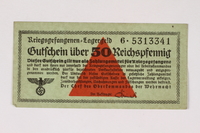
German Prisoner of War Camp general issue currency, kriegsgefangenen lagergeld, 50 Reichspfennig
Object
German prisoner of war (POW) currency, called kriegsgfangenen lagergeld (war cash), valued at 50 Reichspfennig, distributed to prisoners held in German POW camps from 1939 to 1944. The currency was issued in seven denominations: 1, 10, and 50 Reichspfennig and 1, 2, 5, and 10 Reichsmark. After the beginning of World War II in September, 1939, Nazi Germany established a network of approximately 75 POW camps to house the enemy soldiers they captured across Europe. A prisoner’s treatment inside the camps varied depending on their nationality. Due to the Nazi belief that Soviet prisoners were racially and politically inferior, they were starved and treated brutally, resulting in millions of deaths. However, for Western Allied prisoners, life inside the camps was tough but generally fair, as Germany, with some exceptions, usually followed the Geneva Convention Rules for ethical treatment of POWs. Prisoners received meager rations supplemented with Red Cross food parcels and, with the exception of officers, were required to work, often performing hard labor. To compensate the prisoners for their work, Germany distributed currency that was to be used in the POW camps. The notes only held value in the POW camps and their official use was for the purchase of goods from the canteens. However, the canteens were poorly stocked, which rendered the notes essentially worthless. Many prisoners used the notes for gambling among themselves to combat boredom. The notes were discontinued in 1944. In response, prisoners in Polish camps created their own currency for internal use.
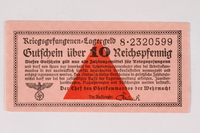
German Prisoner of War Camp general issue currency, kriegsgefangenen lagergeld, 10 Reichspfennig
Object
German prisoner of war (POW) currency, called kriegsgfangenen lagergeld (war cash), valued at 10 Reichspfennig, distributed to prisoners held in German POW camps from 1939 to 1944. The currency was issued in seven denominations: 1, 10, and 50 Reichspfennig and 1, 2, 5, and 10 Reichsmark. After the beginning of World War II in September, 1939, Nazi Germany established a network of approximately 75 POW camps to house the enemy soldiers they captured across Europe. A prisoner’s treatment inside the camps varied depending on their nationality. Due to the Nazi belief that Soviet prisoners were racially and politically inferior, they were starved and treated brutally, resulting in millions of deaths. However, for Western Allied prisoners, life inside the camps was tough but generally fair, as Germany, with some exceptions, usually followed the Geneva Convention Rules for ethical treatment of POWs. Prisoners received meager rations supplemented with Red Cross food parcels and, with the exception of officers, were required to work, often performing hard labor. To compensate the prisoners for their work, Germany distributed currency that was to be used in the POW camps. The notes only held value in the POW camps and their official use was for the purchase of goods from the canteens. However, the canteens were poorly stocked, which rendered the notes essentially worthless. Many prisoners used the notes for gambling among themselves to combat boredom. The notes were discontinued in 1944. In response, prisoners in Polish camps created their own currency for internal use.
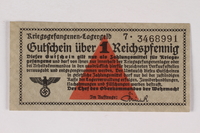
German Prisoner of War Camp general issue currency, kriegsgefangenen lagergeld, 1 Reichspfennig
Object
German prisoner of war (POW) currency, called kriegsgfangenen lagergeld (war cash), valued at 1 Reichspfennig, distributed to prisoners held in German POW camps from 1939 to 1944. The currency was issued in seven denominations: 1, 10, and 50 Reichspfennig and 1, 2, 5, and 10 Reichsmark. After the beginning of World War II in September, 1939, Nazi Germany established a network of approximately 75 POW camps to house the enemy soldiers they captured across Europe. A prisoner’s treatment inside the camps varied depending on their nationality. Due to the Nazi belief that Soviet prisoners were racially and politically inferior, they were starved and treated brutally, resulting in millions of deaths. However, for Western Allied prisoners, life inside the camps was tough but generally fair, as Germany, with some exceptions, usually followed the Geneva Convention Rules for ethical treatment of POWs. Prisoners received meager rations supplemented with Red Cross food parcels and, with the exception of officers, were required to work, often performing hard labor. To compensate the prisoners for their work, Germany distributed currency that was to be used in the POW camps. The notes only held value in the POW camps and their official use was for the purchase of goods from the canteens. However, the canteens were poorly stocked, which rendered the notes essentially worthless. Many prisoners used the notes for gambling among themselves to combat boredom. The notes were discontinued in 1944. In response, prisoners in Polish camps created their own currency for internal use.
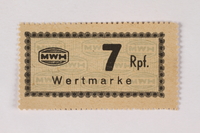
Holleischen subcamp scrip, 7 Reichspfennig note
Object
Scrip, valued at 7 Reichspfennig, distributed at the Metallwerke Holleischen GmbH munitions factory in Holleischen, a subcamp of Flossenbürg concentration camp in Germany. While held at the camp, inmates were compelled to work in the factory. A special currency was issued to incentivize work output, although the money had no real monetary value. The scrip has a repeating “MWH” across the note, representing the Metallwerke Holleischen GmbH logo, and was printed in 17 denominations ranging in value from 1 Reichspfennig (rpf) to 5 Reichsmark (rm). The Holleischen subcamp was established in Czechoslovakia, near the German-Czech border, in 1941. It included a men’s camp and a women’s camp, and all inmates were forced to work either in the factory or in construction. Initially, the camps were constructed for Czech forced laborers, but in June 1941, the first French and Russian prisoners of war (POWs) arrived in the men’s camp. In the women’s camp, by 1944, the majority of the prisoners were French, followed by Polish people and Russians. There were hardly any Jews in the camp until March 1945, when a group of Hungarian Jewish women were transported from Nürnberg, a Flossenbürg subcamp, following its evacuation. Polish partisans liberated the Holleischen subcamp on May 3, 1945. American troops arrived two days later.
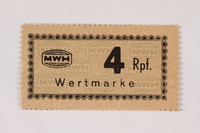
Holleischen subcamp scrip, 4 Reichspfennig note
Object
Scrip, valued at 4 Reichspfennig, distributed at the Metallwerke Holleischen GmbH munitions factory in Holleischen, a subcamp of Flossenbürg concentration camp in Germany. While held at the camp, inmates were compelled to work in the factory. A special currency was issued to incentivize work output, although the money had no real monetary value. The scrip has a repeating “MWH” across the note, representing the Metallwerke Holleischen GmbH logo, and was printed in 17 denominations ranging in value from 1 Reichspfennig (rpf) to 5 Reichsmark (rm). The Holleischen subcamp was established in Czechoslovakia, near the German-Czech border, in 1941. It included a men’s camp and a women’s camp, and all inmates were forced to work either in the factory or in construction. Initially, the camps were constructed for Czech forced laborers, but in June 1941, the first French and Russian prisoners of war (POWs) arrived in the men’s camp. In the women’s camp, by 1944, the majority of the prisoners were French, followed by Polish people and Russians. There were hardly any Jews in the camp until March 1945, when a group of Hungarian Jewish women were transported from Nürnberg, a Flossenbürg subcamp, following its evacuation. Polish partisans liberated the Holleischen subcamp on May 3, 1945. American troops arrived two days later.
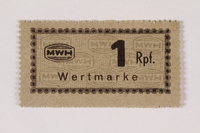
Holleischen subcamp scrip, 1 Reichspfennig note
Object
Scrip, valued at 1 Reichspfennig, distributed at the Metallwerke Holleischen GmbH munitions factory in Holleischen, a subcamp of Flossenbürg concentration camp in Germany. While held at the camp, inmates were compelled to work in the factory. A special currency was issued to incentivize work output, although the money had no real monetary value. The scrip has a repeating “MWH” across the note, representing the Metallwerke Holleischen GmbH logo, and was printed in 17 denominations ranging in value from 1 Reichspfennig (rpf) to 5 Reichsmark (rm). The Holleischen subcamp was established in Czechoslovakia, near the German-Czech border, in 1941. It included a men’s camp and a women’s camp, and all inmates were forced to work either in the factory or in construction. Initially, the camps were constructed for Czech forced laborers, but in June 1941, the first French and Russian prisoners of war (POWs) arrived in the men’s camp. In the women’s camp, by 1944, the majority of the prisoners were French, followed by Polish people and Russians. There were hardly any Jews in the camp until March 1945, when a group of Hungarian Jewish women were transported from Nürnberg, a Flossenbürg subcamp, following its evacuation. Polish partisans liberated the Holleischen subcamp on May 3, 1945. American troops arrived two days later.
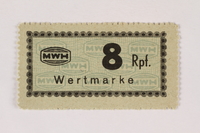
Holleischen subcamp scrip, 8 Reichspfennig note
Object
Scrip, valued at 8 Reichspfennig, distributed at the Metallwerke Holleischen GmbH munitions factory in Holleischen, a subcamp of Flossenbürg concentration camp in Germany. While held at the camp, inmates were compelled to work in the factory. A special currency was issued to incentivize work output, although the money had no real monetary value. The scrip has a repeating “MWH” across the note, representing the Metallwerke Holleischen GmbH logo, and was printed in 17 denominations ranging in value from 1 Reichspfennig (rpf) to 5 Reichsmark (rm). The Holleischen subcamp was established in Czechoslovakia, near the German-Czech border, in 1941. It included a men’s camp and a women’s camp, and all inmates were forced to work either in the factory or in construction. Initially, the camps were constructed for Czech forced laborers, but in June 1941, the first French and Russian prisoners of war (POWs) arrived in the men’s camp. In the women’s camp, by 1944, the majority of the prisoners were French, followed by Polish people and Russians. There were hardly any Jews in the camp until March 1945, when a group of Hungarian Jewish women were transported from Nürnberg, a Flossenbürg subcamp, following its evacuation. Polish partisans liberated the Holleischen subcamp on May 3, 1945. American troops arrived two days later.
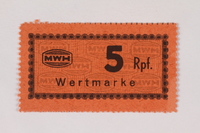
Holleischen subcamp scrip, 5 Reichspfennig note
Object
Scrip, valued at 5 Reichspfennig, distributed at the Metallwerke Holleischen GmbH munitions factory in Holleischen, a subcamp of Flossenbürg concentration camp in Germany. While held at the camp, inmates were compelled to work in the factory. A special currency was issued to incentivize work output, although the money had no real monetary value. The scrip has a repeating “MWH” across the note, representing the Metallwerke Holleischen GmbH logo, and was printed in 17 denominations ranging in value from 1 Reichspfennig (rpf) to 5 Reichsmark (rm). The Holleischen subcamp was established in Czechoslovakia, near the German-Czech border, in 1941. It included a men’s camp and a women’s camp, and all inmates were forced to work either in the factory or in construction. Initially, the camps were constructed for Czech forced laborers, but in June 1941, the first French and Russian prisoners of war (POWs) arrived in the men’s camp. In the women’s camp, by 1944, the majority of the prisoners were French, followed by Polish people and Russians. There were hardly any Jews in the camp until March 1945, when a group of Hungarian Jewish women were transported from Nürnberg, a Flossenbürg subcamp, following its evacuation. Polish partisans liberated the Holleischen subcamp on May 3, 1945. American troops arrived two days later.
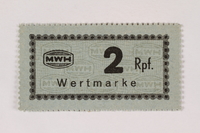
Holleischen subcamp scrip, 2 Reichspfennig note
Object
Scrip, valued at 2 Reichspfennig, distributed at the Metallwerke Holleischen GmbH munitions factory in Holleischen, a subcamp of Flossenbürg concentration camp in Germany. While held at the camp, inmates were compelled to work in the factory. A special currency was issued to incentivize work output, although the money had no real monetary value. The scrip has a repeating “MWH” across the note, representing the Metallwerke Holleischen GmbH logo, and was printed in 17 denominations ranging in value from 1 Reichspfennig (rpf) to 5 Reichsmark (rm). The Holleischen subcamp was established in Czechoslovakia, near the German-Czech border, in 1941. It included a men’s camp and a women’s camp, and all inmates were forced to work either in the factory or in construction. Initially, the camps were constructed for Czech forced laborers, but in June 1941, the first French and Russian prisoners of war (POWs) arrived in the men’s camp. In the women’s camp, by 1944, the majority of the prisoners were French, followed by Polish people and Russians. There were hardly any Jews in the camp until March 1945, when a group of Hungarian Jewish women were transported from Nürnberg, a Flossenbürg subcamp, following its evacuation. Polish partisans liberated the Holleischen subcamp on May 3, 1945. American troops arrived two days later.
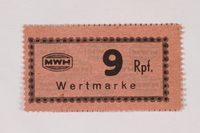
Holleischen subcamp scrip, 9 Reichspfennig note
Object
Scrip, valued at 9 Reichspfennig, distributed at the Metallwerke Holleischen GmbH munitions factory in Holleischen, a subcamp of Flossenbürg concentration camp in Germany. While held at the camp, inmates were compelled to work in the factory. A special currency was issued to incentivize work output, although the money had no real monetary value. The scrip has a repeating “MWH” across the note, representing the Metallwerke Holleischen GmbH logo, and was printed in 17 denominations ranging in value from 1 Reichspfennig (rpf) to 5 Reichsmark (rm). The Holleischen subcamp was established in Czechoslovakia, near the German-Czech border, in 1941. It included a men’s camp and a women’s camp, and all inmates were forced to work either in the factory or in construction. Initially, the camps were constructed for Czech forced laborers, but in June 1941, the first French and Russian prisoners of war (POWs) arrived in the men’s camp. In the women’s camp, by 1944, the majority of the prisoners were French, followed by Polish people and Russians. There were hardly any Jews in the camp until March 1945, when a group of Hungarian Jewish women were transported from Nürnberg, a Flossenbürg subcamp, following its evacuation. Polish partisans liberated the Holleischen subcamp on May 3, 1945. American troops arrived two days later.
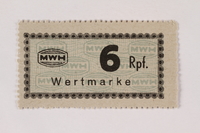
Holleischen subcamp scrip, 6 Reichspfennig note
Object
Scrip, valued at 6 Reichspfennig, distributed at the Metallwerke Holleischen GmbH munitions factory in Holleischen, a subcamp of Flossenbürg concentration camp in Germany. While held at the camp, inmates were compelled to work in the factory. A special currency was issued to incentivize work output, although the money had no real monetary value. The scrip has a repeating “MWH” across the note, representing the Metallwerke Holleischen GmbH logo, and was printed in 17 denominations ranging in value from 1 Reichspfennig (rpf) to 5 Reichsmark (rm). The Holleischen subcamp was established in Czechoslovakia, near the German-Czech border, in 1941. It included a men’s camp and a women’s camp, and all inmates were forced to work either in the factory or in construction. Initially, the camps were constructed for Czech forced laborers, but in June 1941, the first French and Russian prisoners of war (POWs) arrived in the men’s camp. In the women’s camp, by 1944, the majority of the prisoners were French, followed by Polish people and Russians. There were hardly any Jews in the camp until March 1945, when a group of Hungarian Jewish women were transported from Nürnberg, a Flossenbürg subcamp, following its evacuation. Polish partisans liberated the Holleischen subcamp on May 3, 1945. American troops arrived two days later.
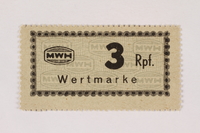
Holleischen subcamp scrip, 3 Reichspfennig note
Object
Scrip, valued at 3 Reichspfennig, distributed at the Metallwerke Holleischen GmbH munitions factory in Holleischen, a subcamp of Flossenbürg concentration camp in Germany. While held at the camp, inmates were compelled to work in the factory. A special currency was issued to incentivize work output, though the money had no real monetary value. The scrip has a repeating “MWH” across the note, representing the Metallwerke Holleischen GmbH logo, and was printed in 17 denominations ranging in value from 1 Reichspfennig (rpf) to 5 Reichsmark (rm). The Holleischen subcamp was established in Czechoslovakia, near the German-Czech border, in 1941. It included a men’s camp and a women’s camp, and all inmates were forced to work either in the factory or in construction. Initially, the camps were constructed for Czech forced laborers, but in June 1941, the first French and Russian prisoners of war (POWs) arrived in the men’s camp. In the women’s camp, by 1944, the majority of the prisoners were French, followed by Polish people and Russians. There were hardly any Jews in the camp until March 1945, when a group of Hungarian Jewish women were transported from Nürnberg, a Flossenbürg subcamp, following its evacuation. Polish partisans liberated the Holleischen subcamp on May 3, 1945. American troops arrived two days later.
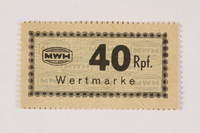
Holleischen subcamp scrip, 40 Reichspfennig note
Object
Scrip, valued at 40 Reichspfennig, distributed at the Metallwerke Holleischen GmbH munitions factory in Holleischen, a subcamp of Flossenbürg concentration camp in Germany. While held at the camp, inmates were compelled to work in the factory. A special currency was issued to incentivize work output, although the money had no real monetary value. The scrip has a repeating “MWH” across the note, representing the Metallwerke Holleischen GmbH logo, and was printed in 17 denominations ranging in value from 1 Reichspfennig (rpf) to 5 Reichsmark (rm). The Holleischen subcamp was established in Czechoslovakia, near the German-Czech border, in 1941. It included a men’s camp and a women’s camp, and all inmates were forced to work either in the factory or in construction. Initially, the camps were constructed for Czech forced laborers, but in June 1941, the first French and Russian prisoners of war (POWs) arrived in the men’s camp. In the women’s camp, by 1944, the majority of the prisoners were French, followed by Polish people and Russians. There were hardly any Jews in the camp until March 1945, when a group of Hungarian Jewish women were transported from Nürnberg, a Flossenbürg subcamp, following its evacuation. Polish partisans liberated the Holleischen subcamp on May 3, 1945. American troops arrived two days later.
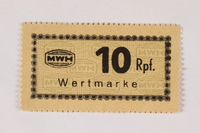
Holleischen subcamp scrip, 10 Reichspfennig note
Object
Scrip, valued at 10 Reichspfennig, distributed at the Metallwerke Holleischen GmbH munitions factory in Holleischen, a subcamp of Flossenbürg concentration camp in Germany. While held at the camp, inmates were compelled to work in the factory. A special currency was issued to incentivize work output, although the money had no real monetary value. The scrip has a repeating “MWH” across the note, representing the Metallwerke Holleischen GmbH logo, and was printed in 17 denominations ranging in value from 1 Reichspfennig (rpf) to 5 Reichsmark (rm). The Holleischen subcamp was established in Czechoslovakia, near the German-Czech border, in 1941. It included a men’s camp and a women’s camp, and all inmates were forced to work either in the factory or in construction. Initially, the camps were constructed for Czech forced laborers, but in June 1941, the first French and Russian prisoners of war (POWs) arrived in the men’s camp. In the women’s camp, by 1944, the majority of the prisoners were French, followed by Polish people and Russians. There were hardly any Jews in the camp until March 1945, when a group of Hungarian Jewish women were transported from Nürnberg, a Flossenbürg subcamp, following its evacuation. Polish partisans liberated the Holleischen subcamp on May 3, 1945. American troops arrived two days later.
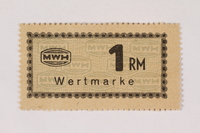
Holleischen subcamp scrip, 1 Reichsmark note
Object
Scrip, valued at 1 Reichsmark, distributed at the Metallwerke Holleischen GmbH munitions factory in Holleischen, a subcamp of Flossenbürg concentration camp in Germany. While held at the camp, inmates were compelled to work in the factory. A special currency was issued to incentivize work output, although the money had no real monetary value. The scrip has a repeating “MWH” across the note, representing the Metallwerke Holleischen GmbH logo, and was printed in 17 denominations ranging in value from 1 Reichspfennig (rpf) to 5 Reichsmark (rm). The Holleischen subcamp was established in Czechoslovakia, near the German-Czech border, in 1941. It included a men’s camp and a women’s camp, and all inmates were forced to work either in the factory or in construction. Initially, the camps were constructed for Czech forced laborers, but in June 1941, the first French and Russian prisoners of war (POWs) arrived in the men’s camp. In the women’s camp, by 1944, the majority of the prisoners were French, followed by Polish people and Russians. There were hardly any Jews in the camp until March 1945, when a group of Hungarian Jewish women were transported from Nürnberg, a Flossenbürg subcamp, following its evacuation. Polish partisans liberated the Holleischen subcamp on May 3, 1945. American troops arrived two days later.
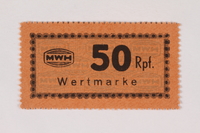
Holleischen subcamp scrip, 50 Reichspfennig note
Object
Scrip, valued at 50 Reichspfennig, distributed at the Metallwerke Holleischen GmbH munitions factory in Holleischen, a subcamp of Flossenbürg concentration camp in Germany. While held at the camp, inmates were compelled to work in the factory. A special currency was issued to incentivize work output, although the money had no real monetary value. The scrip has a repeating “MWH” across the note, representing the Metallwerke Holleischen GmbH logo, and was printed in 17 denominations ranging in value from 1 Reichspfennig (rpf) to 5 Reichsmark (rm). The Holleischen subcamp was established in Czechoslovakia, near the German-Czech border, in 1941. It included a men’s camp and a women’s camp, and all inmates were forced to work either in the factory or in construction. Initially, the camps were constructed for Czech forced laborers, but in June 1941, the first French and Russian prisoners of war (POWs) arrived in the men’s camp. In the women’s camp, by 1944, the majority of the prisoners were French, followed by Polish people and Russians. There were hardly any Jews in the camp until March 1945, when a group of Hungarian Jewish women were transported from Nürnberg, a Flossenbürg subcamp, following its evacuation. Polish partisans liberated the Holleischen subcamp on May 3, 1945. American troops arrived two days later.
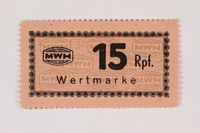
Holleischen subcamp scrip, 15 Reichspfennig note
Object
Scrip, valued at 15 Reichspfennig, distributed at the Metallwerke Holleischen GmbH munitions factory in Holleischen, a subcamp of Flossenbürg concentration camp in Germany. While held at the camp, inmates were compelled to work in the factory. A special currency was issued to incentivize work output, although the money had no real monetary value. The scrip has a repeating “MWH” across the note, representing the Metallwerke Holleischen GmbH logo, and was printed in 17 denominations ranging in value from 1 Reichspfennig (rpf) to 5 Reichsmark (rm). The Holleischen subcamp was established in Czechoslovakia, near the German-Czech border, in 1941. It included a men’s camp and a women’s camp, and all inmates were forced to work either in the factory or in construction. Initially, the camps were constructed for Czech forced laborers, but in June 1941, the first French and Russian prisoners of war (POWs) arrived in the men’s camp. In the women’s camp, by 1944, the majority of the prisoners were French, followed by Polish people and Russians. There were hardly any Jews in the camp until March 1945, when a group of Hungarian Jewish women were transported from Nürnberg, a Flossenbürg subcamp, following its evacuation. Polish partisans liberated the Holleischen subcamp on May 3, 1945. American troops arrived two days later.
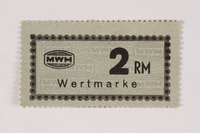
Holleischen subcamp scrip, 2 Reichsmark note
Object
Scrip, valued at 2 Reichsmark, distributed at the Metallwerke Holleischen GmbH munitions factory in Holleischen, a subcamp of Flossenbürg concentration camp in Germany. While held at the camp, inmates were compelled to work in the factory. A special currency was issued to incentivize work output, although the money had no real monetary value. The scrip has a repeating “MWH” across the note, representing the Metallwerke Holleischen GmbH logo, and was printed in 17 denominations ranging in value from 1 Reichspfennig (rpf) to 5 Reichsmark (rm). The Holleischen subcamp was established in Czechoslovakia, near the German-Czech border, in 1941. It included a men’s camp and a women’s camp, and all inmates were forced to work either in the factory or in construction. Initially, the camps were constructed for Czech forced laborers, but in June 1941, the first French and Russian prisoners of war (POWs) arrived in the men’s camp. In the women’s camp, by 1944, the majority of the prisoners were French, followed by Polish people and Russians. There were hardly any Jews in the camp until March 1945, when a group of Hungarian Jewish women were transported from Nürnberg, a Flossenbürg subcamp, following its evacuation. Polish partisans liberated the Holleischen subcamp on May 3, 1945. American troops arrived two days later.
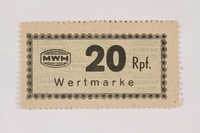
Holleischen subcamp scrip, 20 Reichspfennig note
Object
Scrip, valued at 20 Reichspfennig, distributed at the Metallwerke Holleischen GmbH munitions factory in Holleischen, a subcamp of Flossenbürg concentration camp in Germany. While held at the camp, inmates were compelled to work in the factory. A special currency was issued to incentivize work output, although the money had no real monetary value. The scrip has a repeating “MWH” across the note, representing the Metallwerke Holleischen GmbH logo, and was printed in 17 denominations ranging in value from 1 Reichspfennig (rpf) to 5 Reichsmark (rm). The Holleischen subcamp was established in Czechoslovakia, near the German-Czech border, in 1941. It included a men’s camp and a women’s camp, and all inmates were forced to work either in the factory or in construction. Initially, the camps were constructed for Czech forced laborers, but in June 1941, the first French and Russian prisoners of war (POWs) arrived in the men’s camp. In the women’s camp, by 1944, the majority of the prisoners were French, followed by Polish people and Russians. There were hardly any Jews in the camp until March 1945, when a group of Hungarian Jewish women were transported from Nürnberg, a Flossenbürg subcamp, following its evacuation. Polish partisans liberated the Holleischen subcamp on May 3, 1945. American troops arrived two days later.
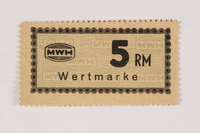
Holleischen subcamp scrip, 5 Reichsmark note
Object
Scrip, valued at 5 Reichsmark, distributed at the Metallwerke Holleischen GmbH munitions factory in Holleischen, a subcamp of Flossenbürg concentration camp in Germany. While held at the camp, inmates were compelled to work in the factory. A special currency was issued to incentivize work output, although the money had no real monetary value. The scrip has a repeating “MWH” across the note, representing the Metallwerke Holleischen GmbH logo, and was printed in 17 denominations ranging in value from 1 Reichspfennig (rpf) to 5 Reichsmark (rm). The Holleischen subcamp was established in Czechoslovakia, near the German-Czech border, in 1941. It included a men’s camp and a women’s camp, and all inmates were forced to work either in the factory or in construction. Initially, the camps were constructed for Czech forced laborers, but in June 1941, the first French and Russian prisoners of war (POWs) arrived in the men’s camp. In the women’s camp, by 1944, the majority of the prisoners were French, followed by Polish people and Russians. There were hardly any Jews in the camp until March 1945, when a group of Hungarian Jewish women were transported from Nürnberg, a Flossenbürg subcamp, following its evacuation. Polish partisans liberated the Holleischen subcamp on May 3, 1945. American troops arrived two days later.
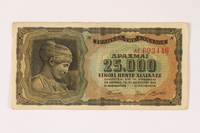
German issued Greek currency, 25,000 Drachmai note
Object
German-issued Greek National currency valued at 25,000 Drachmai. The Greek currency, called Drachma, can be traced back to the 6th century BC. The currency was discontinued after the Roman conquest of Greece, and reissued after Greece gained independence from the Ottoman Empire. Many of the reissued notes included figures and images from Greek mythology. Featured on this note is Deidamia of Scyros, wife of the hero, Achilles, and mother of his son, Neoptolemus. The image on the reverse is likely the Temple of Hera, one of the oldest monuments in Greece. On October 28, 1940, Italy invaded Greece, but they were repelled by the Greek forces. On April 6, 1941, Germany invaded Greece to support Italy and forced the Grecians to surrender by the end of the month. Germany, Italy, and Bulgaria collectively occupied Greece until Italy’s surrender to the Allies in September 1943. Then Germany occupied all of Greece, and forced the Greek government to pay for the occupation by printing more paper money with higher denominations. The excess Drachmai caused hyperinflation, and the price for goods and services rose dramatically. During the occupation, the price of corn was 9 million Drachmai per pound. The essentially worthless paper bills gave way to bartering of supplies such as olive oil, cigarettes, and wheat. Due to the invasion and the harsh economic policies, hundreds of thousands Grecians died from lack of food during the German occupation.
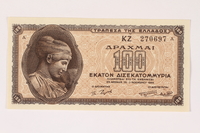
German issued Greek currency, 100 billion Drachmai note
Object
German-issued Greek National currency valued at 100 billion Drachmai. The Greek currency, called Drachma, can be traced back to the 6th century BC. The currency was discontinued after the Roman conquest of Greece, and reissued after Greece gained independence from the Ottoman Empire. Many of the Greek notes featured figures and images from Greek Mythology. Featured on this note are the king and queen of the Olympian gods, Zeus and Hera; the Cretan Bull, which was captured by Heracles; and Deidamia of Scyros who was Achilles’ wife, and mother of his son, Neoptolemus. On October 28, 1940, Italy invaded Greece, but they were repelled by the Greek forces. On April 6, 1941, Germany invaded Greece to support Italy and forced the Grecians to surrender by the end of the month. Germany, Italy, and Bulgaria collectively occupied Greece until Italy’s surrender to the Allies in September 1943. Then Germany occupied all of Greece, and forced the Greek government to pay for the occupation by printing more paper money with higher denominations. The excess Drachmai caused hyperinflation, and the price for goods and services rose dramatically. During the occupation, the price of corn was 9 million Drachmai per pound. The essentially worthless paper bills gave way to bartering of supplies such as olive oil, cigarettes, and wheat. Due to the invasion and the harsh economic policies, hundreds of thousands Grecians died from lack of food during the German occupation.
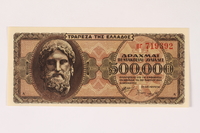
German issued Greek currency, 500,000 Drachmai note
Object
German-issued Greek National currency valued at 500,000 Drachmai. The Greek currency, called Drachma, can be traced back to the 6th century BC. The currency was discontinued after the Roman conquest of Greece, and reissued after Greece gained independence from the Ottoman Empire. Many of the Greek notes featured figures and images from Greek Mythology. Featured on this note is Zeus, god of thunder, and king of the Olympian gods. On October 28, 1940, Italy invaded Greece, but they were repelled by the Greek forces. On April 6, 1941, Germany invaded Greece to support Italy and forced the Grecians to surrender by the end of the month. Germany, Italy, and Bulgaria collectively occupied Greece until Italy’s surrender to the Allies in September 1943. Then Germany occupied all of Greece, and forced the Greek government to pay for the occupation by printing more paper money with higher denominations. The excess Drachmai caused hyperinflation, and the price for goods and services rose dramatically. During the occupation, the price of corn was 9 million Drachmai per pound. The essentially worthless paper bills gave way to bartering of supplies such as olive oil, cigarettes, and wheat. Due to the invasion and the harsh economic policies, hundreds of thousands Grecians died from lack of food during the German occupation.
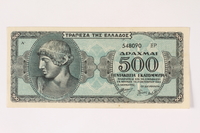
German issued Greek currency, 500 million Drachmai note
Object
German-issued Greek National currency valued at 500 million Drachmai. The Greek currency, called Drachma, can be traced back to the 6th century BC. The currency was discontinued after the Roman conquest of Greece, and reissued after Greece gained independence from the Ottoman Empire. Many of the Greek notes featured figures and images from Greek Mythology. Featured on this note is Apollo, the god of music, poetry, and art among many other things. The reverse features an image from The Parthenon Frieze. On October 28, 1940, Italy invaded Greece, but they were repelled by the Greek forces. On April 6, 1941, Germany invaded Greece to support Italy and forced the Grecians to surrender by the end of the month. Germany, Italy, and Bulgaria collectively occupied Greece until Italy’s surrender to the Allies in September 1943. Then Germany occupied all of Greece, and forced the Greek government to pay for the occupation by printing more paper money with higher denominations. The excess Drachmai caused hyperinflation, and the price for goods and services rose dramatically. During the occupation, the price of corn was 9 million Drachmai per pound. The essentially worthless paper bills gave way to bartering of supplies such as olive oil, cigarettes, and wheat. Due to the invasion and the harsh economic policies, hundreds of thousands Grecians died from lack of food during the German occupation.
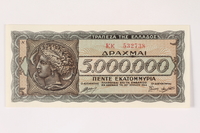
German issued Greek currency, 5,000,000 Drachmai note
Object
German-issued Greek National currency valued at 5,000,000 Drachmai. The Greek currency, called Drachma, can be traced back to the 6th century BC. The currency was discontinued after the Roman conquest of Greece, and reissued after Greece gained independence from the Ottoman Empire. Many of the Greek notes featured figures and images from Greek Mythology. Featured on this note is Arethusa, a nymph who was loved by the water god Alpheus and changed into a spring by the goddess Artemis. On October 28, 1940, Italy invaded Greece, but they were repelled by the Greek forces. On April 6, 1941, Germany invaded Greece to support Italy and forced the Grecians to surrender by the end of the month. Germany, Italy, and Bulgaria collectively occupied Greece until Italy’s surrender to the Allies in September 1943. Then Germany occupied all of Greece, and forced the Greek government to pay for the occupation by printing more paper money with higher denominations. The excess Drachmai caused hyperinflation, and the price for goods and services rose dramatically. During the occupation, the price of corn was 9 million Drachmai per pound. The essentially worthless paper bills gave way to bartering of supplies such as olive oil, cigarettes, and wheat. Due to the invasion and the harsh economic policies, hundreds of thousands Grecians died from lack of food during the German occupation.
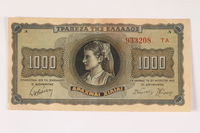
German issued Greek currency, 1,000 Drachmai note
Object
German- issued Greek National currency valued at 1,000 Drachmai. The Greek currency, called Drachma, can be traced back to the 6th century BC. The currency was discontinued after the Roman conquest of Greece, and reissued after Greece gained independence from the Ottoman Empire. Many of the Greek notes featured figures and images from Greek Mythology and history. Featured on this note is the Lion of Amphipolis, a monument erected in the late 4th century BCE for Laomedon of Mytilene, a general of Alexander the Great. The face features a portrait of a woman from the island of Thasos. On October 28, 1940, Italy invaded Greece, but they were repelled by the Greek forces. On April 6, 1941, Germany invaded Greece to support Italy and forced the Grecians to surrender by the end of the month. Germany, Italy, and Bulgaria collectively occupied Greece until Italy’s surrender to the Allies in September 1943. Then Germany occupied all of Greece, and forced the Greek government to pay for the occupation by printing more paper money with higher denominations. The excess Drachmai caused hyperinflation, and the price for goods and services rose dramatically. During the occupation, the price of corn was 9 million Drachmai per pound. The essentially worthless paper bills gave way to bartering of supplies such as olive oil, cigarettes, and wheat. Due to the invasion and the harsh economic policies, hundreds of thousands Grecians died from lack of food during the German occupation.
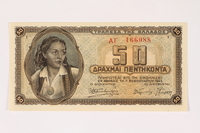
German issued Greek currency, 50 Drachmai note
Object
German-issued Greek National currency valued at 50 Drachmai. The Greek currency, called Drachma, can be traced back to the 6th century BC. The currency was discontinued after the Roman conquest of Greece, and reissued after Greece gained independence from the Ottoman Empire. Many of the Greek notes featured figures and images from Greek Mythology and history. Featured on this note is a coin with the images of the king and queen of the Olympian gods, Zeus and Hera, and the Cretan Bull, which was captured by Heracles. On the opposite side is an image of a woman from Paramithia in traditional dress. On October 28, 1940, Italy invaded Greece, but they were repelled by the Greek forces. On April 6, 1941, Germany invaded Greece to support Italy and forced the Greeks to surrender by the end of the month. Germany, Italy, and Bulgaria collectively occupied Greece until Italy’s surrender to the Allies in September 1943. Then Germany occupied all of Greece, and forced the Greek government to pay for the occupation by printing more paper money with higher denominations. The excess Drachmai caused hyperinflation, and the price for goods and services rose dramatically. During the occupation, the price of corn was 9 million Drachmai per pound. The essentially worthless paper bills gave way to bartering of supplies such as olive oil, cigarettes, and wheat. Due to the invasion and the harsh economic policies, hundreds of thousands of Greeks died from lack of food during the German occupation.
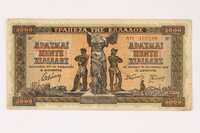
German issued Greek currency, 5,000 Drachmai note
Object
German-issued Greek National currency valued at 5,000 Drachmai. The Greek currency, called Drachma, can be traced back to the 6th century BC. The currency was discontinued after the Roman conquest of Greece, and reissued after Greece gained independence from the Ottoman Empire. Many of the Greek notes featured figures and images from Greek Mythology and history. Featured on this note is an image of the Winged Victory of Samothrace, a marble statue of Nike, the goddess of victory, discovered on the island of Samothrace on April 15, 1863. On April 6, 1941, Germany invaded Greece to support Italy and forced the Greeks to surrender by the end of the month. Germany, Italy, and Bulgaria collectively occupied Greece until Italy’s surrender to the Allies in September 1943. Then Germany occupied all of Greece, and forced the Greek government to pay for the occupation by printing more paper money with higher denominations. The excess Drachmai caused hyperinflation, and the price for goods and services rose dramatically. During the occupation, the price of corn was 9 million Drachmai per pound. The essentially worthless paper bills gave way to bartering of supplies such as olive oil, cigarettes, and wheat. Due to the invasion and the harsh economic policies, hundreds of thousands of Greeks died from lack of food during the German occupation.
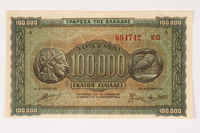
German issued Greek currency, 100,000 Drachmai note
Object
German-issued Greek National currency valued at 100,000 Drachmai. The Greek currency, called Drachma, can be traced back to the 6th century BC. The currency was discontinued after the Roman conquest of Greece, and reissued after Greece gained independence from the Ottoman Empire. Many of the Greek notes featured figures and images from Greek Mythology and history. Featured on this note is a Tetradrachm, an ancient coin with an image of an owl and the face of Athena, goddess of wisdom and courage. The reverse shows the Temple of Aphaea (Aphaia or Afea) on the island of Aigina. On April 6, 1941, Germany invaded Greece to support Italy and forced the Greeks to surrender by the end of the month. Germany, Italy, and Bulgaria collectively occupied Greece until Italy’s surrender to the Allies in September 1943. Then Germany occupied all of Greece, and forced the Greek government to pay for the occupation by printing more paper money with higher denominations. The excess Drachmai caused hyperinflation, and the price for goods and services rose dramatically. During the occupation, the price of corn was 9 million Drachmai per pound. The essentially worthless paper bills gave way to bartering of supplies such as olive oil, cigarettes, and wheat. Due to the invasion and the harsh economic policies, hundreds of thousands of Greeks died from lack of food during the German occupation.
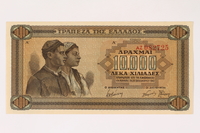
German issued Greek currency, 10,000 Drachmai note
Object
German-issued Greek National currency valued at 10,000 Drachmai. The Greek currency, called Drachma, can be traced back to the 6th century BC. The currency was discontinued after the Roman conquest of Greece, and reissued after Greece gained independence from the Ottoman Empire. Many of the Greek notes featured figures and images from Greek Mythology and history. The reverse has an image of the Treasury of Athens which was built to hold the offerings to the Delphi oracle. On April 6, 1941, Germany invaded Greece to support Italy and forced the Greeks to surrender by the end of the month. Germany, Italy, and Bulgaria collectively occupied Greece until Italy’s surrender to the Allies in September 1943. Then Germany occupied all of Greece, and forced the Greek government to pay for the occupation by printing more paper money with higher denominations. The excess Drachmai caused hyperinflation, and the price for goods and services rose dramatically. During the occupation, the price of corn was 9 million Drachmai per pound. The essentially worthless paper bills gave way to bartering of supplies such as olive oil, cigarettes, and wheat. Due to the invasion and the harsh economic policies, hundreds of thousands of Greeks died from lack of food during the German occupation.
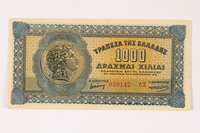
German issued Greek currency, 1,000 Drachmai note
Object
German-issued Greek National currency valued at 1,000 Drachmai. The Greek currency, called Drachma, can be traced back to the 6th century BC. The currency was discontinued after the Roman conquest of Greece, and reissued after Greece gained independence from the Ottoman Empire. Many of the Greek notes featured figures and images from Greek Mythology and history. Featured on this note is an ancient coin with a profile image of Alexander the Great, king of Macedonia and a Greek hero. The reverse has an image of one of the Edessa waterfalls, one of the most renowned waterfalls in Greece. On April 6, 1941, Germany invaded Greece to support Italy and forced the Greeks to surrender by the end of the month. Germany, Italy, and Bulgaria collectively occupied Greece until Italy’s surrender to the Allies in September 1943. Then Germany occupied all of Greece, and forced the Greek government to pay for the occupation by printing more paper money with higher denominations. The excess Drachmai caused hyperinflation, and the price for goods and services rose dramatically. During the occupation, the price of corn was 9 million Drachmai per pound. The essentially worthless paper bills gave way to bartering of supplies such as olive oil, cigarettes, and wheat. Due to the invasion and the harsh economic policies, hundreds of thousands of Greeks died from lack of food during the German occupation.
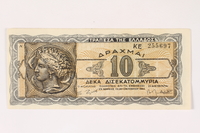
German issued Greek currency, 10 billon Drachmai note
Object
German-issued Greek National currency valued at 10 billion Drachmai. The Greek currency, called Drachma, can be traced back to the 6th century BC. The currency was discontinued after the Roman conquest of Greece, and reissued after Greece gained independence from the Ottoman Empire. Many of the Greek notes featured figures and images from Greek Mythology and history. Featured on this note is a coin with the image of Arethusa, a nymph who was loved by the water god Alpheus and changed into a spring by the goddess Artemis. On October 28, 1940, Italy invaded Greece, but they were repelled by the Greek forces. On April 6, 1941, Germany invaded Greece to support Italy and forced the Grecians to surrender by the end of the month. Germany, Italy, and Bulgaria collectively occupied Greece until Italy’s surrender to the Allies in September 1943. Then Germany occupied all of Greece, and forced the Greek government to pay for the occupation by printing more paper money with higher denominations. The excess Drachmai caused hyperinflation, and the price for goods and services rose dramatically. During the occupation, the price of corn was 9 million Drachmai per pound. The essentially worthless paper bills gave way to bartering of supplies such as olive oil, cigarettes, and wheat. Due to the invasion and the harsh economic policies, hundreds of thousands Grecians died from lack of food during the German occupation.
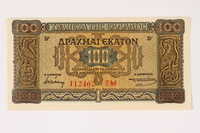
German issued Greek currency, 100 Drachmai note
Object
German-issued Greek National currency valued at 100 Drachmai. The Greek currency, called Drachma, can be traced back to the 6th century BC. The currency was discontinued after the Roman conquest of Greece, and reissued after Greece gained independence from the Ottoman Empire. Many of the Greek notes featured figures and images from Greek Mythology and history. Featured on this note is the church of Panagia Kapnikarea. It is thought that the church was built around 1050. It is also believed to be one of the oldest churches in Athens. On October 28, 1940, Italy invaded Greece, but they were repelled by the Greek forces. On April 6, 1941, Germany invaded Greece to support Italy and forced the Grecians to surrender by the end of the month. Germany, Italy, and Bulgaria collectively occupied Greece until Italy’s surrender to the Allies in September 1943. Then Germany occupied all of Greece, and forced the Greek government to pay for the occupation by printing more paper money with higher denominations. The excess Drachmai caused hyperinflation, and the price for goods and services rose dramatically. During the occupation, the price of corn was 9 million Drachmai per pound. The essentially worthless paper bills gave way to bartering of supplies such as olive oil, cigarettes, and wheat. Due to the invasion and the harsh economic policies, hundreds of thousands Grecians died from lack of food during the German occupation.
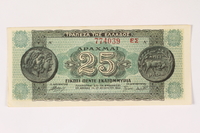
German issued Greek currency, 25 million Drachmai note
Object
German-issued Greek National currency valued at 25 million Drachmai. The Greek currency, called Drachma, can be traced back to the 6th century BC. The currency was discontinued after the Roman conquest of Greece, and reissued after Greece gained independence from the Ottoman Empire. Many of the Greek notes featured figures and images from Greek Mythology and history. Featured on this note is a coin with the images of the king and queen of the Olympian gods, Zeus and Hera, and the Cretan Bull, which was captured by Heracles. On April 6, 1941, Germany invaded Greece to support Italy and forced the Greeks to surrender by the end of the month. Germany, Italy, and Bulgaria collectively occupied Greece until Italy’s surrender to the Allies in September 1943. Then Germany occupied all of Greece, and forced the Greek government to pay for the occupation by printing more paper money with higher denominations. The excess Drachmai caused hyperinflation, and the price for goods and services rose dramatically. During the occupation, the price of corn was 9 million Drachmai per pound. The essentially worthless paper bills gave way to bartering of supplies such as olive oil, cigarettes, and wheat. Due to the invasion and the harsh economic policies, hundreds of thousands of Greeks died from lack of food during the German occupation.
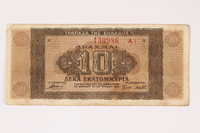
German issued Greek currency, 10 million Drachmai note
Object
German-issued Greek National currency valued at 10 million Drachmai. The Greek currency, called Drachma, can be traced back to the 6th century BC. The currency was discontinued after the Roman conquest of Greece, and reissued after Greece gained independence from the Ottoman Empire. On April 6, 1941, Germany invaded Greece to support Italy and forced the Greeks to surrender by the end of the month. Germany, Italy, and Bulgaria collectively occupied Greece until Italy’s surrender to the Allies in September 1943. Then Germany occupied all of Greece, and forced the Greek government to pay for the occupation by printing more paper money with higher denominations. The excess Drachmai caused hyperinflation, and the price for goods and services rose dramatically. During the occupation, the price of corn was 9 million Drachmai per pound. The essentially worthless paper bills gave way to bartering of supplies such as olive oil, cigarettes, and wheat. Due to the invasion and the harsh economic policies, hundreds of thousands of Greeks died from lack of food during the German occupation.
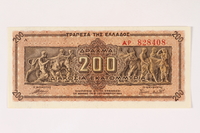
German issued Greek currency, 200 million Drachmai note
Object
German-issued Greek National currency valued at 200 million Drachmai. The Greek currency, called Drachma, can be traced back to the 6th century BC. The currency was discontinued after the Roman conquest of Greece, and reissued after Greece gained independence from the Ottoman Empire. Many of the Greek notes featured figures and images from Greek Mythology and history. Featured on this note is a partial image of the South frieze of the Parthenon in Athens. The frieze shows the procession of the Panathenaic festival, commemorating the birthday of the goddess Athena. On April 6, 1941, Germany invaded Greece to support Italy and forced the Greeks to surrender by the end of the month. Germany, Italy, and Bulgaria collectively occupied Greece until Italy’s surrender to the Allies in September 1943. Then Germany occupied all of Greece, and forced the Greek government to pay for the occupation by printing more paper money with higher denominations. The excess Drachmai caused hyperinflation, and the price for goods and services rose dramatically. During the occupation, the price of corn was 9 million Drachmai per pound. The essentially worthless paper bills gave way to bartering of supplies such as olive oil, cigarettes, and wheat. Due to the invasion and the harsh economic policies, hundreds of thousands of Greeks died from lack of food during the German occupation.
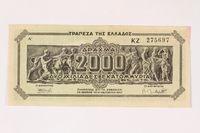
German issued Greek currency, 2 billion Drachmai note
Object
German-issued Greek National currency valued at 2 billion Drachmai. The Greek currency, called Drachma, can be traced back to the 6th century BC. The currency was discontinued after the Roman conquest of Greece, and reissued after Greece gained independence from the Ottoman Empire. Many of the Greek notes featured figures and images from Greek Mythology and history. Featured on this note is a partial image of the South Frieze of the Parthenon in Athens. The frieze shows the procession of the Panathenaic festival, commemorating the birthday of the goddess Athena. On April 6, 1941, Germany invaded Greece to support Italy and forced the Greeks to surrender by the end of the month. Germany, Italy, and Bulgaria collectively occupied Greece until Italy’s surrender to the Allies in September 1943. Then Germany occupied all of Greece, and forced the Greek government to pay for the occupation by printing more paper money with higher denominations. The excess Drachmai caused hyperinflation, and the price for goods and services rose dramatically. During the occupation, the price of corn was 9 million Drachmai per pound. The essentially worthless paper bills gave way to bartering of supplies such as olive oil, cigarettes, and wheat. Due to the invasion and the harsh economic policies, hundreds of thousands of Greeks died from lack of food during the German occupation.
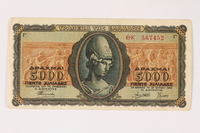
German issued Greek currency, 5,000 Drachmai note
Object
German-issued Greek National currency valued at 5,000 Drachmai. The Greek currency, called Drachma, can be traced back to the 6th century BC. The currency was discontinued after the Roman conquest of Greece, and reissued after Greece gained independence from the Ottoman Empire. Many of the Greek notes featured figures and images from Greek Mythology and history. Featured on this note is Athena, goddess of wisdom and courage. The reverse features an image from The Parthenon Frieze, block W X. On October 28, 1940, Italy invaded Greece, but they were repelled by the Greek forces. On April 6, 1941, Germany invaded Greece to support Italy and forced the Greeks to surrender by the end of the month. Germany, Italy, and Bulgaria collectively occupied Greece until Italy’s surrender to the Allies in September 1943. Then Germany occupied all of Greece, and forced the Greek government to pay for the occupation by printing more paper money with higher denominations. The excess Drachmai caused hyperinflation, and the price for goods and services rose dramatically. During the occupation, the price of corn was 9 million Drachmai per pound. The essentially worthless paper bills gave way to bartering of supplies such as olive oil, cigarettes, and wheat. Due to the invasion and the harsh economic policies, hundreds of thousands of Greeks died from lack of food during the German occupation.
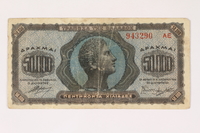
German issued Greek currency, 50,000 Drachmai note
Object
German-issued Greek National currency valued at 50,000 Drachmai. The Greek currency, called Drachma, can be traced back to the 6th century BC. The currency was discontinued after the Roman conquest of Greece, and reissued after Greece gained independence from the Ottoman Empire. Many of the Greek notes featured figures and images from Greek Mythology and history. Featured on this note is a bust of an athlete. Athletics has a long tradition in Greece, with many city states holding their own individual competitions and also competing against each other in the Panhellenic games and the ancient Olympics. Only Greek citizens were allowed to compete, and the victors brought honor to themselves, their families, and their hometowns. On April 6, 1941, Germany invaded Greece to support Italy and forced the Greeks to surrender by the end of the month. Germany, Italy, and Bulgaria collectively occupied Greece until Italy’s surrender to the Allies in September 1943. Then Germany occupied all of Greece, and forced the Greek government to pay for the occupation by printing more paper money with higher denominations. The excess Drachmai caused hyperinflation, and the price for goods and services rose dramatically. During the occupation, the price of corn was 9 million Drachmai per pound. The essentially worthless paper bills gave way to bartering of supplies such as olive oil, cigarettes, and wheat. Due to the invasion and the harsh economic policies, hundreds of thousands of Greeks died from lack of food during the German occupation.
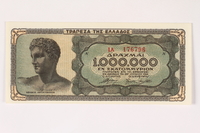
German issued Greek currency, 1,000,000 Drachmai note
Object
German-issued Greek National currency valued at 1 million Drachmai. The Greek currency, called Drachma, can be traced back to the 6th century BC. The currency was discontinued after the Roman conquest of Greece, and reissued after Greece gained independence from the Ottoman Empire. Many of the Greek notes featured figures and images from Greek Mythology and history. Featured on the face is an image of the head of the Antikythera Ephebe (also known as the Antikythera Youth), a bronze statue of a young man discovered in 1900 by sponge-divers off the island of Antikythera, Greece. The reverse features an image of the ruins of the Temple of Poseidon at the Cape of Sounion. On April 6, 1941, Germany invaded Greece to support Italy and forced the Greeks to surrender by the end of the month. Germany, Italy, and Bulgaria collectively occupied Greece until Italy’s surrender to the Allies in September 1943. Then Germany occupied all of Greece, and forced the Greek government to pay for the occupation by printing more paper money with higher denominations. The excess Drachmai caused hyperinflation, and the price for goods and services rose dramatically. During the occupation, the price of corn was 9 million Drachmai per pound. The essentially worthless paper bills gave way to bartering of supplies such as olive oil, cigarettes, and wheat. Due to the invasion and the harsh economic policies, hundreds of thousands of Greeks died from lack of food during the German occupation.
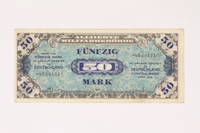
Allied Military currency for Germany, 50 mark note
Object
Allied Military currency (AMC), valued at 50 mark, printed in the Soviet Union and distributed for use in Germany by the Allied Military Government for Occupied Territories (AMGOT), from September 1944 to June 1948. During and immediately after World War II, the Allied powers worked cooperatively to issue special currency for Allied troops in countries they had liberated or newly occupied. The goal of the joint currency issues was to protect local economies from inflation or weakening of their currency, and to present a united front to countries they were occupying and those they were still fighting. The currency was produced for Italy, France, Germany, Austria, and Japan. All of the production was carried out in secret, and the printing effort for each country was given its own code name. The printing of the Allied Military (AM) mark for Germany was known as Operation Wild Dog. The United States did the majority of the printing for the notes used in each country, but the Soviet Union insisted on being allowed to print a portion of the notes for use in Germany. With the ability to print their own notes, the Soviet Union was able to ignore the wishes of the other allies, and issue large numbers of AM marks to Soviet troops. This indiscriminate printing led to inflation issues in occupied Germany. On June 20, 1948, the American, British, and French occupation zones of Germany converted to a new currency, and the Soviets followed suit a few days later.
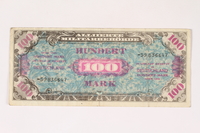
Allied Military currency for Germany, 100 mark note
Object
Allied Military currency (AMC), valued at 100 mark, printed in the Soviet Union and distributed for use in Germany by the Allied Military Government for Occupied Territories (AMGOT), from September 1944 to June 1948. During and immediately after World War II, the Allied powers worked cooperatively to issue special currency for Allied troops in countries they had liberated or newly occupied. The goal of the joint currency issues was to protect local economies from inflation or weakening of their currency, and to present a united front to countries they were occupying and those they were still fighting. The currency was produced for Italy, France, Germany, Austria, and Japan. All of the production was carried out in secret, and the printing effort for each country was given its own code name. The printing of the Allied Military (AM) mark for Germany was known as Operation Wild Dog. The United States did the majority of the printing for the notes used in each country, but the Soviet Union insisted on being allowed to print a portion of the notes for use in Germany. With the ability to print their own notes, the Soviet Union was able to ignore the wishes of the other allies, and issue large numbers of AM marks to Soviet troops. This indiscriminate printing led to inflation issues in occupied Germany. On June 20, 1948, the American, British, and French occupation zones of Germany converted to a new currency, and the Soviets followed suit a few days later.
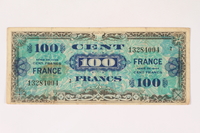
Allied Military currency for France, 100 franc note
Object
Second issue Allied Military currency (AMC), valued at 100 francs, distributed for use in France by the Allied Military Government for Occupied Territories (AMGOT), from June 1945 to July 1946. During and immediately after World War II, the Allied powers worked cooperatively to issue special currency for Allied troops in countries they had liberated or occupied. The goal of the joint currency issues was to protect local economies from inflation or weakening of their currency, and to present a united front. The currency was produced for Italy, France, Germany, Austria, and Japan. All of the production was carried out in secret, and the printing effort for each country was given its own code name. The printing of the Allied Military (AM) francs for France was known as Operation Tom Cat, and notes were issued two different times. The first issue included a French flag on the back, and was called the supplemental franc. The second issue replaced the flag with the word France, and was called the provisional franc. Both issues were printed under strict security measures by the Forbes Lithograph Manufacturing Company in Boston, Massachusetts. Allied forces brought the first notes with them on D-Day, June 6, 1944, when they stormed the beaches of Normandy to liberate France from the Germans. The notes were distributed under the orders of General Eisenhower, but the leader of the French Resistance, General Charles de Gaulle, called the AM francs counterfeit money and protested their use. The provisional notes replaced the supplemental notes in June of 1945, but quickly faded out of use.
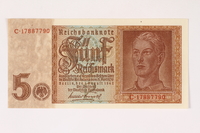
German Reichsbank, 5 Reichsmark note
Object
Reichsbank note, valued at 5 Reichsmark, distributed in Germany from August 1942 to 1948. The Reichsmark became the national currency of Germany in 1924, replacing the Rentenmark, which had been issued as temporary currency in 1923. The Rentenmark was created to address the economic hyperinflation that had been brought on by Germany’s actions following World War I, and smooth the transition from the worthless Papiermark to the Reichsmark. Originally, the Reichsmark was backed by the gold standard, but was taken off that and stood alone following the 1929 market crash. It was initially issued in values of 10, 20, 50, 100, and 1000, but in 1942, the 5 Reichsmark note was introduced. It was designed to replace the silver, 5 Reichsmark coins that people were hoarding for the perceived value of the silver. The note includes multiple examples of imagery and symbolism valued by the Nazi party. The front features a young, German man with the idealized Aryan features, and the Reichsbank seal with the Reichsadler gripping a swastika in the center. The back includes an image of the Brunswick Cathedral (Dom St. Blasii) and Brunswick Lion statue, symbols of Germany’s long history. The image is flanked by depictions of an agrarian woman representing farming and a male laborer representing industry, two aspects of society that the Nazi party viewed as the basis for economic prosperity. The Reichsmark was officially replaced by the Deutsche Mark in 1945, when Germany was placed under allied occupation, but it remained legal tender until 1948.
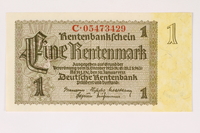
German Rentenbank, 1 Rentenmark note
Object
Rentenbank note, valued at 1 Rentenmark, distributed for use in Germany from January 1937 to 1948. The Rentenmark became the national currency in 1923 to address the hyperinflation ruining the German economy following World War I. Before the Rentenmark was introduced, the former national currency, the Papiermark, was valued at 4.2 billion marks to one U.S. dollar, and was backed by gold, which the treasury did not have. In order to stabilize the economy, the German government established the Rentenbank on October 15, 1923, and the new Minister of Finance, Hans Luther, developed a system where the Rentenmark was backed by mortgage on all real property in Germany, rather than gold. The Rentenmark was set at 4.2 marks to one U.S. dollar, and its introduction successfully ended the inflation crisis. The Rentenmark was meant to be temporary and it was officially replaced as the national currency by the Reichsmark in 1924, but both notes remained legal tender. In 1937, the German government utilized the Rentenbank to issue 1 and 2 Rentenmark notes because the Reichsbank did not issue denominations lower than 5 Reichsmarks. Both notes included an image of a sheaf of wheat on the back, the emblem of the Rentenbank. When France, Britain, the United States, and the Soviet Union placed Germany under allied occupation in 1945, the Deutsche Mark became the official Germany currency, but the Rentenmark and the Reichsmark both remained in circulation until 1948.
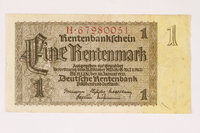
German Rentenbank, 1 Rentenmark note
Object
Rentenbank note, valued at 1 Rentenmark, distributed for use in Germany from January 1937 to 1948. The Rentenmark became the national currency in 1923 to address the hyperinflation ruining the German economy following World War I. Before the Rentenmark was introduced, the former national currency, the Papiermark, was valued at 4.2 billion marks to one U.S. dollar, and was backed by gold, which the treasury did not have. In order to stabilize the economy, the German government established the Rentenbank on October 15, 1923, and the new Minister of Finance, Hans Luther, developed a system where the Rentenmark was backed by mortgage on all real property in Germany, rather than gold. The Rentenmark was set at 4.2 marks to one U.S. dollar, and its introduction successfully ended the inflation crisis. The Rentenmark was meant to be temporary and it was officially replaced as the national currency by the Reichsmark in 1924, but both notes remained legal tender. In 1937, the German government utilized the Rentenbank to issue 1 and 2 Rentenmark notes because the Reichsbank did not issue denominations lower than 5 Reichsmarks. Both notes included an image of a sheaf of wheat on the back, the emblem of the Rentenbank. When France, Britain, the United States, and the Soviet Union placed Germany under allied occupation in 1945, the Deutsche Mark became the official Germany currency, but the Rentenmark and the Reichsmark both remained in circulation until 1948.
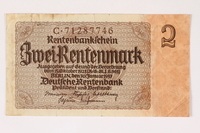
German Rentenbank, 2 Rentenmark note
Object
Rentenbank note, valued at 2 Rentenmark, distributed for use in Germany from January 1937 to 1948. The Rentenmark became the national currency in 1923 to address the hyperinflation ruining the German economy following World War I. Before the Rentenmark was introduced, the former national currency, the Papiermark, was valued at 4.2 billion marks to one U.S. dollar, and was backed by gold, which the treasury did not have. In order to stabilize the economy, the German government established the Rentenbank on October 15, 1923, and the new Minister of Finance, Hans Luther, developed a system where the Rentenmark was backed by mortgage on all real property in Germany, rather than gold. The Rentenmark was set at 4.2 marks to one U.S. dollar, and its introduction successfully ended the inflation crisis. The Rentenmark was meant to be temporary and it was officially replaced as the national currency by the Reichsmark in 1924, but both notes remained legal tender. In 1937, the German government utilized the Rentenbank to issue 1 and 2 Rentenmark notes because the Reichsbank did not issue denominations lower than 5 Reichsmarks. Both notes included an image of a sheaf of wheat on the back, the emblem of the Rentenbank. When France, Britain, the United States, and the Soviet Union placed Germany under allied occupation in 1945, the Deutsche Mark became the official Germany currency, but the Rentenmark and the Reichsmark both remained in circulation until 1948.
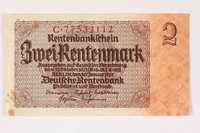
German Rentenbank, 2 Rentenmark note
Object
Rentenbank note, valued at 2 Rentenmark, distributed for use in Germany from January 1937 to 1948. The Rentenmark became the national currency in 1923 to address the hyperinflation ruining the German economy following World War I. Before the Rentenmark was introduced, the former national currency, the Papiermark, was valued at 4.2 billion marks to one U.S. dollar, and was backed by gold, which the treasury did not have. In order to stabilize the economy, the German government established the Rentenbank on October 15, 1923, and the new Minister of Finance, Hans Luther, developed a system where the Rentenmark was backed by mortgage on all real property in Germany, rather than gold. The Rentenmark was set at 4.2 marks to one U.S. dollar, and its introduction successfully ended the inflation crisis. The Rentenmark was meant to be temporary and it was officially replaced as the national currency by the Reichsmark in 1924, but both notes remained legal tender. In 1937, the German government utilized the Rentenbank to issue 1 and 2 Rentenmark notes because the Reichsbank did not issue denominations lower than 5 Reichsmarks. Both notes included an image of a sheaf of wheat on the back, the emblem of the Rentenbank. When France, Britain, the United States, and the Soviet Union placed Germany under allied occupation in 1945, the Deutsche Mark became the official Germany currency, but the Rentenmark and the Reichsmark both remained in circulation until 1948.
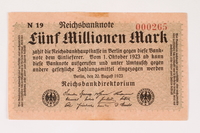
Weimar Germany Reichsbanknote, 5 million mark
Object
Reichsbank note, valued at 5 million marks, distributed in Germany from August to November 1923. German efforts to finance World War I sent the nation into debt. Following their defeat, the Treaty of Versailles obligated Germany to pay reparations to several countries, which increased the nation’s financial struggles. The German government attempted to solve this problem by printing more money, which led to severe inflation. The inflation grew to critical levels between 1922 and1923, when the exchange rate of the mark to the United States dollar went from 2,000 marks per dollar to well over a million in a matter of months. The government printed higher and higher denominations, but was unable to keep up with the plunging rates. Germans began using the worthless bills as kindling, wallpaper, and children’s crafts. The emerging National Socialist German Worker’s (Nazi) Party frequently used the bills to their advantage, writing anti-Semitic messages on them, which blamed Jews for Germany’s financial problems. In order to stabilize the economy, the German government established the Rentenbank. The new Minister of Finance, Hans Luther, created the Rentenmark, which was backed by mortgages on all real property in Germany, rather than gold. The Rentenmark was valued at 4.2 marks to one U.S. dollar, and its introduction on November 16, 1923, successfully ended the inflation crisis. Despite this, the Nazi Party continued to use people’s residual economic fears as a propaganda tool to gain power, eventually leading to Adolf Hitler becoming Chancellor in 1933.
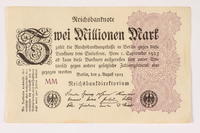
Weimar Germany Reichsbanknote, 2 million mark
Object
Reichsbank note, valued at 2 million marks, distributed in Germany from August to November 1923. German efforts to finance World War I sent the nation into debt. Following their defeat, the Treaty of Versailles obligated Germany to pay reparations to several countries, which increased the nation’s financial struggles. The German government attempted to solve this problem by printing more money, which led to severe inflation. The inflation grew to critical levels between 1922 and1923, when the exchange rate of the mark to the United States dollar went from 2,000 marks per dollar to well over a million in a matter of months. The government printed higher and higher denominations, but was unable to keep up with the plunging rates. Germans began using the worthless bills as kindling, wallpaper, and children’s crafts. The emerging National Socialist German Worker’s (Nazi) Party frequently used the bills to their advantage, writing anti-Semitic messages on them, which blamed Jews for Germany’s financial problems. In order to stabilize the economy, the German government established the Rentenbank. The new Minister of Finance, Hans Luther, created the Rentenmark, which was backed by mortgages on all real property in Germany, rather than gold. The Rentenmark was valued at 4.2 marks to one U.S. dollar, and its introduction on November 16, 1923, successfully ended the inflation crisis. Despite this, the Nazi Party continued to use people’s residual economic fears as a propaganda tool to gain power, eventually leading to Adolf Hitler becoming Chancellor in 1933.
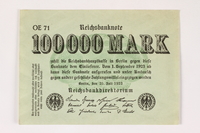
Weimar Germany Reichsbanknote, 100,000 mark
Object
Reichsbank note, valued at 100,000 marks, distributed in Germany from July to November 1923. German efforts to finance World War I sent the nation into debt. Following their defeat, the Treaty of Versailles obligated Germany to pay reparations to several countries, which increased the nation’s financial struggles. The German government attempted to solve this problem by printing more money, which led to severe inflation. The inflation grew to critical levels between 1922 and1923, when the exchange rate of the mark to the United States dollar went from 2,000 marks per dollar to well over a million in a matter of months. The government printed higher and higher denominations, but was unable to keep up with the plunging rates. Germans began using the worthless bills as kindling, wallpaper, and children’s crafts. The emerging National Socialist German Worker’s (Nazi) Party frequently used the bills to their advantage, writing anti-Semitic messages on them, which blamed Jews for Germany’s financial problems. In order to stabilize the economy, the German government established the Rentenbank. The new Minister of Finance, Hans Luther, created the Rentenmark, which was backed by mortgages on all real property in Germany, rather than gold. The Rentenmark was valued at 4.2 marks to one U.S. dollar, and its introduction on November 16, 1923, successfully ended the inflation crisis. Despite this, the Nazi Party continued to use people’s residual economic fears as a propaganda tool to gain power, eventually leading to Adolf Hitler becoming Chancellor in 1933.
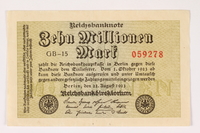
Weimar Germany Reichsbanknote, ten million mark
Object
Reichsbank note, valued at 10 million marks, distributed in Germany from August to November 1923. German efforts to finance World War I sent the nation into debt. Following their defeat, the Treaty of Versailles obligated Germany to pay reparations to several countries, which increased the nation’s financial struggles. The German government attempted to solve this problem by printing more money, which led to severe inflation. The inflation grew to critical levels between 1922 and1923, when the exchange rate of the mark to the United States dollar went from 2,000 marks per dollar to well over a million in a matter of months. The government printed higher and higher denominations, but was unable to keep up with the plunging rates. Germans began using the worthless bills as kindling, wallpaper, and children’s crafts. The emerging National Socialist German Worker’s (Nazi) Party frequently used the bills to their advantage, writing anti-Semitic messages on them, which blamed Jews for Germany’s financial problems. In order to stabilize the economy, the German government established the Rentenbank. The new Minister of Finance, Hans Luther, created the Rentenmark, which was backed by mortgages on all real property in Germany, rather than gold. The Rentenmark was valued at 4.2 marks to one U.S. dollar, and its introduction on November 16, 1923, successfully ended the inflation crisis. Despite this, the Nazi Party continued to use people’s residual economic fears as a propaganda tool to gain power, eventually leading to Adolf Hitler becoming Chancellor in 1933.

Weimar Germany Reichsbanknote, 1 million mark
Object
Reichsbank note, valued at 1 million marks, distributed in Germany from August to November 1923. German efforts to finance World War I sent the nation into debt. Following their defeat, the Treaty of Versailles obligated Germany to pay reparations to several countries, which increased the nation’s financial struggles. The German government attempted to solve this problem by printing more money, which led to severe inflation. The inflation grew to critical levels between 1922 and1923, when the exchange rate of the mark to the United States dollar went from 2,000 marks per dollar to well over a million in a matter of months. The government printed higher and higher denominations, but was unable to keep up with the plunging rates. Germans began using the worthless bills as kindling, wallpaper, and children’s crafts. The emerging National Socialist German Worker’s (Nazi) Party frequently used the bills to their advantage, writing anti-Semitic messages on them, which blamed Jews for Germany’s financial problems. In order to stabilize the economy, the German government established the Rentenbank. The new Minister of Finance, Hans Luther, created the Rentenmark, which was backed by mortgages on all real property in Germany, rather than gold. The Rentenmark was valued at 4.2 marks to one U.S. dollar, and its introduction on November 16, 1923, successfully ended the inflation crisis. Despite this, the Nazi Party continued to use people’s residual economic fears as a propaganda tool to gain power, eventually leading to Adolf Hitler becoming Chancellor in 1933.
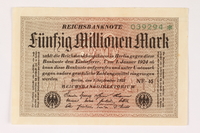
Weimar Germany Reichsbanknote, 50 million mark
Object
Reichsbank note, valued at 50 million marks, distributed in Germany from September to November 1923. German efforts to finance World War I sent the nation into debt. Following their defeat, the Treaty of Versailles obligated Germany to pay reparations to several countries, which increased the nation’s financial struggles. The German government attempted to solve this problem by printing more money, which led to severe inflation. The inflation grew to critical levels between 1922 and 1923, when the exchange rate of the mark to the United States dollar went from 2,000 marks per dollar to well over a million in a matter of months. The government printed higher and higher denominations, but was unable to keep up with the plunging rates. Germans began using the worthless bills as kindling, wallpaper, and children’s crafts. The emerging National Socialist German Worker’s (Nazi) Party frequently used the bills to their advantage, writing anti-Semitic messages on them, which blamed Jews for Germany’s financial problems. In order to stabilize the economy, the German government established the Rentenbank. The new Minister of Finance, Hans Luther, created the Rentenmark, which was backed by mortgages on all real property in Germany, rather than gold. The Rentenmark was valued at 4.2 marks to one U.S. dollar, and its introduction on November 16, 1923, successfully ended the inflation crisis. Despite this, the Nazi Party continued to use people’s residual economic fears as a propaganda tool to gain power, eventually leading to Adolf Hitler becoming Chancellor in 1933.
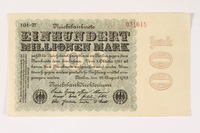
Weimar Germany Reichsbanknote, 100 million mark
Object
Reichsbank note, valued at 100 million marks, distributed in Germany from August to November 1923. German efforts to finance World War I sent the nation into debt. Following their defeat, the Treaty of Versailles obligated Germany to pay reparations to several countries, which increased the nation’s financial struggles. The German government attempted to solve this problem by printing more money, which led to severe inflation. The inflation grew to critical levels between 1922 and1923, when the exchange rate of the mark to the United States dollar went from 2,000 marks per dollar to well over a million in a matter of months. The government printed higher and higher denominations, but was unable to keep up with the plunging rates. Germans began using the worthless bills as kindling, wallpaper, and children’s crafts. The emerging National Socialist German Worker’s (Nazi) Party frequently used the bills to their advantage, writing anti-Semitic messages on them, which blamed Jews for Germany’s financial problems. In order to stabilize the economy, the German government established the Rentenbank. The new Minister of Finance, Hans Luther, created the Rentenmark, which was backed by mortgages on all real property in Germany, rather than gold. The Rentenmark was valued at 4.2 marks to one U.S. dollar, and its introduction on November 16, 1923, successfully ended the inflation crisis. Despite this, the Nazi Party continued to use people’s residual economic fears as a propaganda tool to gain power, eventually leading to Adolf Hitler becoming Chancellor in 1933.
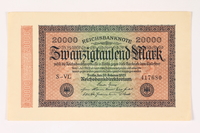
Weimar Germany Reichsbanknote, 20,000 mark
Object
Reichsbank note, valued at 20,000 marks, distributed in Germany from February to November 1923. German efforts to finance World War I sent the nation into debt. Following their defeat, the Treaty of Versailles obligated Germany to pay reparations to several countries, which increased the nation’s financial struggles. The German government attempted to solve this problem by printing more money, which led to severe inflation. The inflation grew to critical levels between 1922 and1923, when the exchange rate of the mark to the United States dollar went from 2,000 marks per dollar to well over a million in a matter of months. The government printed higher and higher denominations, but was unable to keep up with the plunging rates. Germans began using the worthless bills as kindling, wallpaper, and children’s crafts. The emerging National Socialist German Worker’s (Nazi) Party frequently used the bills to their advantage, writing anti-Semitic messages on them, which blamed Jews for Germany’s financial problems. In order to stabilize the economy, the German government established the Rentenbank. The new Minister of Finance, Hans Luther, created the Rentenmark, which was backed by mortgages on all real property in Germany, rather than gold. The Rentenmark was valued at 4.2 marks to one U.S. dollar, and its introduction on November 16, 1923, successfully ended the inflation crisis. Despite this, the Nazi Party continued to use people’s residual economic fears as a propaganda tool to gain power, eventually leading to Adolf Hitler becoming Chancellor in 1933.
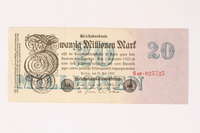
Weimar Germany Reichsbanknote, 20 million mark
Object
Reichsbank note, valued at 20 million marks, distributed in Germany from July to November 1923. German efforts to finance World War I sent the nation into debt. Following their defeat, the Treaty of Versailles obligated Germany to pay reparations to several countries, which increased the nation’s financial struggles. The German government attempted to solve this problem by printing more money, which led to severe inflation. The inflation grew to critical levels between 1922 and1923, when the exchange rate of the mark to the United States dollar went from 2,000 marks per dollar to well over a million in a matter of months. The government printed higher and higher denominations, but was unable to keep up with the plunging rates. Germans began using the worthless bills as kindling, wallpaper, and children’s crafts. The emerging National Socialist German Worker’s (Nazi) Party frequently used the bills to their advantage, writing anti-Semitic messages on them, which blamed Jews for Germany’s financial problems. In order to stabilize the economy, the German government established the Rentenbank. The new Minister of Finance, Hans Luther, created the Rentenmark, which was backed by mortgages on all real property in Germany, rather than gold. The Rentenmark was valued at 4.2 marks to one U.S. dollar, and its introduction on November 16, 1923, successfully ended the inflation crisis. Despite this, the Nazi Party continued to use people’s residual economic fears as a propaganda tool to gain power, eventually leading to Adolf Hitler becoming Chancellor in 1933.
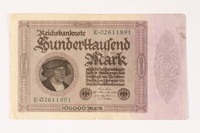
Weimar Germany Reichsbanknote, 100000 mark
Object
Reichsbank note, valued at 100,000 marks, distributed in Germany from February to November 1923. The front medallion depicts German artwork, Portrait of the Merchant Georg Gisze, created in 1532, by Hans Holbein der Jüngere. German efforts to finance World War I sent the nation into debt. Following their defeat, the Treaty of Versailles obligated Germany to pay reparations, which increased the nation’s financial struggles. The German government attempted to solve this problem by printing more money, which led to severe inflation. The inflation grew to critical levels between 1922 and1923, when the exchange rate of the mark to the United States dollar went from 2,000 marks per dollar to well over a million in a matter of months. The government printed higher and higher denominations, but were unable to keep up with the plunging rates. Germans began using the worthless bills as kindling, wallpaper, and children’s crafts. The emerging National Socialist German Worker’s (Nazi) Party frequently used the bills to their advantage, writing anti-Semitic messages on them, which blamed Jews for Germany’s financial problems. In order to stabilize the economy, the German government established the Rentenbank. The new Minister of Finance, Hans Luther, created the Rentenmark, which was backed by mortgages on all real property in Germany, rather than gold. The Rentenmark was valued at 4.2 marks to one U.S. dollar, and its introduction on November 16, 1923, successfully ended the inflation crisis. Despite this, the Nazi Party continued to use people’s residual economic fears as a propaganda tool to gain power, eventually leading to Adolf Hitler becoming Chancellor in 1933.



